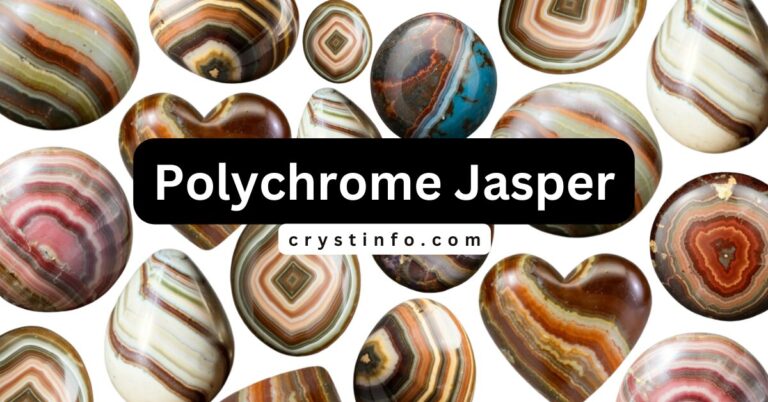Quartz Crystals: Discover the Diverse Types and Versatile Uses
What Are Quartz Crystals?
Quartz Crystals are a resilient, crystalline mineral primarily composed of silica (silicon dioxide). Its atomic structure forms a continuous framework of SiO4 silicon–oxygen tetrahedra, with each oxygen atom shared between two tetrahedra, resulting in a chemical formula of SiO2. Structurally, quartz is classified as a framework silicate mineral and compositionally as an oxide mineral. Abundant in Earth’s continental crust, it ranks as the second most common mineral after feldspar.

Quartz Composition and Structure:
- Quartz is a resilient, crystalline mineral primarily composed of silica (silicon dioxide).
- Its atomic structure forms a continuous framework of SiO4 silicon–oxygen tetrahedra.
- Each oxygen atom is shared between two tetrahedra, resulting in a chemical formula of SiO2.
- Quartz is classified structurally as a framework silicate mineral and compositionally as an oxide mineral.
Abundance and Occurrence:
- Abundant in Earth’s continental crust, quartz ranks as the second most common mineral after feldspar.
- Quartz occurs in various mineral environments and is a crucial constituent of many rocks.
- It is highly resistant to both mechanical and chemical weathering, making it prevalent in igneous, metamorphic, and sedimentary rocks.
- Quartz deposits are found worldwide, from mountaintops to beaches and riverbeds.
Varieties of Quartz:
- Quartz boasts various varieties, several of which are prized as gemstones.
- Throughout history, quartz varieties have been extensively used in jewelry-making and hardstone carvings.
- Notable varieties include agate, amethyst, and rose quartz.
- Minor impurities such as lithium, sodium, potassium, and titanium may be present in quartz varieties.
Uses and Applications:
- Quartz crystals serve various purposes, including their use in oscillators like quartz clocks and semiconductor production.
- Quartz is also a major component of sand and exhibits a mineral hardness of 7 on the Mohs scale.
- “Fused quartz” denotes glass made of silica in a non-crystalline form, prized for its high working and melting temperatures and purity.
- Quartz is widely used in high-tech products due to its unique properties.
Crystallography and Structure:
- Quartz crystals typically exhibit a rhombohedral or hexagonal structure.
- Crystals may be prismatic with horizontally striated prism faces and terminated by a combination of positive and negative rhombohedrons.
- Quartz crystals may be twinned and vary in size from large individuals to fine coatings, manifesting in various forms, including concretionary masses.
- Quartz is one of the most diverse minerals, occurring in numerous forms, habits, and colors, and recognized by more variety names than any other mineral.
Economic Significance of Quartz:
Quartz holds significant economic importance across various industries:
Gemstones:
- Quartz encompasses several gemstone varieties, including amethyst, citrine, smoky quartz, and rose quartz, prized for their beauty and versatility.
Building Materials:
- Sandstone, predominantly composed of quartz, serves as a crucial building stone in construction projects.
Manufacturing and Industrial Uses:
- Quartz sand, also known as silica sand, is a key component in the production of glass, ceramics, and foundry molds for metal casting.
- Crushed quartz functions as an abrasive in sandpaper, while silica sand is utilized in sandblasting applications.
- Sandstone is used whole to manufacture whetstones, millstones, and grindstones.
Optics and Laboratory Applications:
- Silica glass, or fused quartz, is employed in optics to transmit ultraviolet light.
- Fused quartz tubing and vessels find important applications in laboratories.
- Quartz fibers are utilized in highly sensitive weighing devices.
Geological Significance:
Abundance and Occurrence:
- Quartz ranks as the second most abundant mineral in Earth’s crust after feldspar.
- It occurs in various igneous, metamorphic, and sedimentary rocks, including granites, granodiorites, rhyolites, and sandstones.
Weathering Resistance:
- Quartz exhibits high resistance to weathering and tends to concentrate in detrital rocks such as sandstones.
- Secondary quartz acts as a cement in sedimentary rocks, forming overgrowths on detrital grains.
Variability and Structural Forms:
- Quartz exists in two forms: alpha-quartz, stable up to 573°C, and beta-quartz, stable above 573°C.
- The two forms have distinct crystal structures and symmetries.
- Metamorphism of quartz-bearing rocks typically increases the amount of quartz and its grain size.
Piezoelectric Properties:
- Quartz is piezoelectric, developing positive and negative charges on alternate prism edges under pressure or tension.
- This property finds applications in pressure gauges, depth-sounding apparatus, and frequency control in electronic communications equipment, radios, televisions, and crystal-controlled clocks and watches.
| Property | Description |
|---|---|
| Name | Quartz |
| Composition | Silicon dioxide (SiO2) |
| Color | Colorless, white, purple, pink, brown, black, green, yellow, orange, blue, and more; color variations due to impurities or irradiation |
| Crystal System | Hexagonal |
| Hardness | 7 on the Mohs scale |
| Luster | Vitreous |
| Transparency | Transparent to translucent |
| Cleavage | None |
| Fracture | Conchoidal |
| Specific Gravity | 2.65 (for pure quartz) |
| Streak | White |
| Occurrence | Found worldwide; major sources include Brazil, Madagascar, Russia, United States, and many other countries. |
| Uses | – Widely used in jewelry making for gemstones, beads, and cabochons |
| – Utilized in watches and clocks for its piezoelectric properties, which allow it to vibrate at a precise frequency | |
| – Commonly used in various industries, including electronics, optics, and telecommunications | |
| Metaphysical Beliefs | Quartz is believed to amplify energy and intention, making it a popular choice for crystal healing and spiritual practices. It is associated with clarity of mind, spiritual awareness, and harmony. |
| Care Tips | Clean quartz with warm, soapy water and a soft brush. Avoid exposing it to prolonged sunlight or heat, as it may cause fading or damage. Store quartz away from harder minerals to prevent scratching. |
| Note | Quartz is one of the most abundant minerals on Earth and occurs in a wide range of forms and varieties. It is highly versatile and has numerous industrial, decorative, and metaphysical applications. |
Hardness:
Gravity:
History:
- Early Utilization as Tools:
- Quartz has been utilized as a tool since ancient times due to its notable hardness (Mohs hardness scale: 7).
- Its name likely derives from the Slavic word for “hard”, underscoring its durable nature.
- Early human societies fashioned quartz into knives, arrowheads, and flints due to its hardness and sharpness.
- Amulets in the Neolithic Period:
- Rock crystals, a type of quartz known as “white quartz”, were worn as amulets during the Neolithic period.
- These amulets were likely imbued with symbolic or protective significance, reflecting the perceived magical properties of quartz.
- Tradition of Crystal Balls:
- Quartz’s seemingly mystical qualities are evident in the long-standing tradition of using “crystal balls”.
- Crystal balls, typically made of quartz, have been associated with divination and spiritual practices across various cultures.
- Jewelry Gemstone:
- Quartz has been fashioned into jewelry gems for thousands of years, often polished into cabochons.
- Its multifaceted and varied appearance lends itself well to jewelry making, contributing to its enduring popularity.
- Abundance in Earth’s Crust:
- Quartz, comprising crystalline silica, ranks as the second most abundant mineral in the earth’s crust after feldspar.
- Its widespread availability and diverse applications throughout history underscore its significance in human civilization.
Settings And Formation Processes:
Igneous Settings:
- Quartz commonly forms in igneous rocks like granite through the slow cooling and crystallization of magma.
- Slow cooling allows quartz crystals to grow within the rock matrix.
Metamorphic Settings:
- Quartz is present in metamorphic rocks such as marble and schist, which form under high pressure and temperature conditions.
- Recrystallization of pre-existing rocks leads to the formation of quartz within the metamorphic matrix.
Sedimentary Environments:
- Quartz is a major constituent of sedimentary rocks like sandstone, which forms from the accumulation and cementation of sand-sized grains.
- It plays a crucial role in the structure and composition of sandstone formations.
Hydrothermal Deposition:
- Quartz can be deposited from hydrothermal solutions, which are hot, mineral-rich fluids circulating through fractures and pore spaces in rocks.
- Hydrothermal processes contribute to the formation of quartz veins and deposits.
Biomineralization:
- Some living organisms, like plankton and diatoms, produce their skeletons and cell walls using silica, the main component of quartz.
- Biomineralization processes contribute to the formation of quartz-rich deposits over geological time.
Impact on Properties:
- The geological setting and formation process influence the physical and chemical properties of quartz.
- Factors such as color, transparency, crystal shape, and impurities are affected by the specific conditions under which quartz forms.
Occurrence:
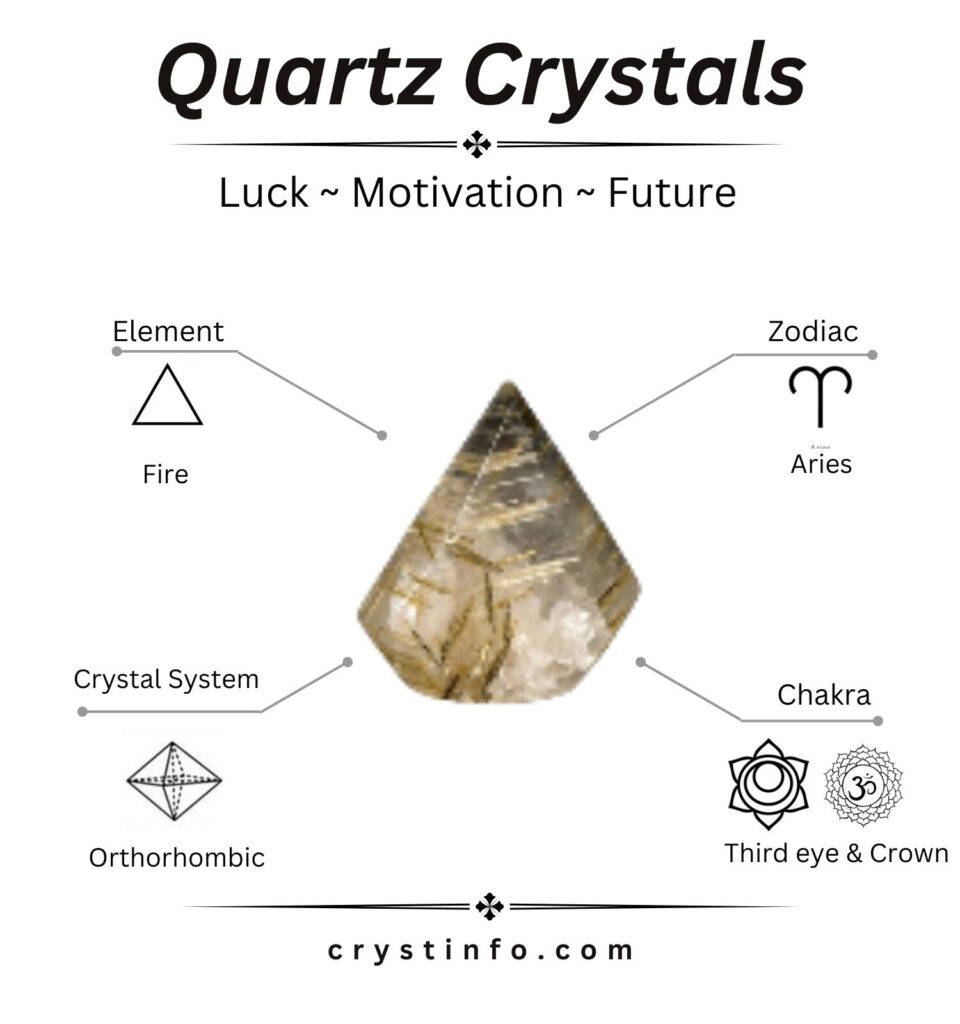
Occurrence in Igneous Rocks:
- Quartz is a significant constituent of silica-rich igneous rocks like granite, rhyolite, and pegmatite.
- It exhibits high resistance to mechanical and chemical weathering, leading to the accumulation of quartz grains in sedimentary rocks like sandstone.
Presence in Metamorphic and Sedimentary Rocks:
- Quartz occurs in metamorphic rocks such as gneisses and schists and is the primary mineral in quartzites.
- It is deposited from solution and commonly forms veins and gangue minerals in various geological formations.
Formation in Sedimentary Environments:
- In sedimentary environments, quartz can form flint nodules when deposited with chalk on the sea floor.
- Solutions carrying silica may replace limestone beds, forming granular cryptocrystalline quartz known as chert.
Association with Other Minerals:
- In rocks, quartz is often associated with minerals like feldspar and muscovite, while in veins, it occurs with a wide range of vein minerals.
- Quartz veins may carry gold, making it an important ore mineral.
Occurrence in Natural Environments:
- Quartz occurs abundantly in sand in stream beds and on seashores, as well as a constituent of soils worldwide.
Notable Occurrences Worldwide:
- Rock crystal is found in the Alps, Minas Geraes (Brazil), Madagascar, and Japan, with notable occurrences in the United States at Hot Springs (Arkansas), Little Falls, and Ellenville (New York).
- Amethyst is found in the Ural Mountains, Czechoslovakia, Tyrol, and Brazil, with occurrences in Thunder Bay (Lake Superior) and various locations in the United States.
- Smoky quartz is found in Switzerland and the United States, notably at Pikes Peak (Colorado), Alexander County (North Carolina), and Auburn (Maine).
Sources:
- The chief source of agates is a region in southern Brazil and northern Uruguay, with many of these agates cut at Oberstein, Germany.
- In the United States, agate is found in Oregon and Wyoming.
Massive Quartz Mining:
- Massive quartz, occurring in veins or with feldspar in pegmatite dikes, is mined in Connecticut, New York, Maryland, and Wisconsin for various commercial purposes.
Habit and Structure:
Crystal System and Ideal Form:
- Quartz belongs to the trigonal crystal system.
- The ideal crystal form of quartz is a six-sided prism terminating with six-sided pyramids at each end.
Variations in Natural Quartz Crystals:
- In nature, quartz crystals often exhibit variations from the ideal form.
- Crystals may be twinned, with dual right-handed and left-handed crystals.
- They can be distorted or intergrown with adjacent crystals or minerals, obscuring their shape or lacking distinct crystal faces.
Formation and Crystal Growth:
- Well-shaped quartz crystals typically form in voids with unconstrained growth.
- They are often attached at one end to a matrix, with only one termination pyramid present.
- Doubly terminated crystals, where growth occurs freely without attachment, are less common but can be found, as in gypsum.
Geode Formation:
- Geodes represent a scenario where the void is approximately spherical, lined with a bed of crystals pointing inward.
Thermal and electrical properties:
Thermal Expansion:
- Quartz possesses a low thermal expansion coefficient, maintaining dimensional stability across temperature changes.
- This characteristic renders it valuable in precision instruments and optical equipment.
Thermal Conductivity:
- Quartz boasts high thermal conductivity, facilitating rapid and efficient heat transfer.
- Its conductivity properties find applications in dissipating heat, especially in electronic components.
Electrical Conductivity:
- Quartz serves as an excellent electrical insulator, displaying poor electrical conductivity.
- At elevated temperatures, quartz can become conductive, offering insulation in high-temperature applications like electrical wiring and heating elements.
Piezoelectricity:
- Quartz exhibits piezoelectric properties, generating an electrical charge under mechanical stress or pressure.
- This feature makes it suitable for various applications, including pressure sensors, accelerometers, and electronic filters.
Optical Properties:
- Transparent in the visible and ultraviolet spectrum, quartz is utilized in optical devices.
- It demonstrates birefringence, splitting a light beam into polarized beams traveling at different speeds.
- Optical applications include polarizing filters, waveplates, and prisms.
Primary Varieties Of Cryptocrystalline Quartz:
Agate Quartz:
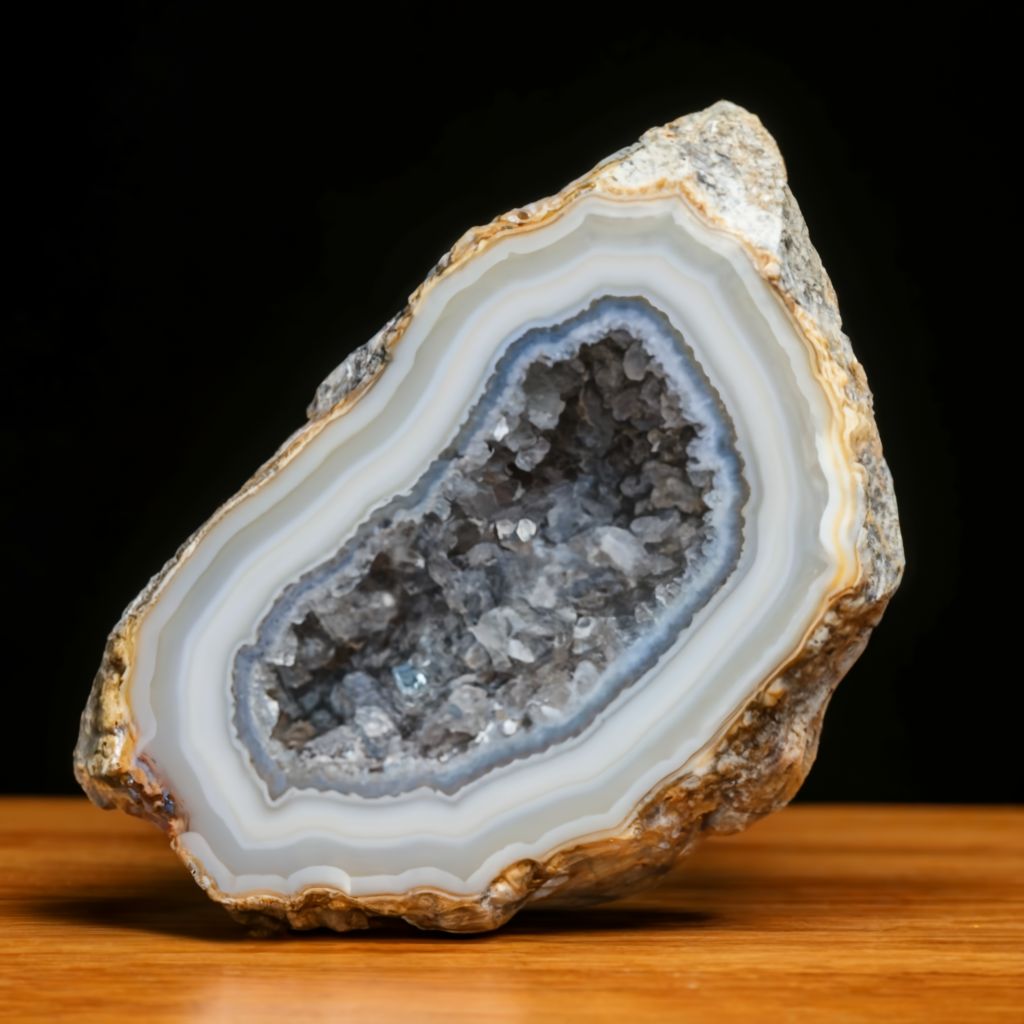
- Chatoyant Gemstone: Agate is a chatoyant gemstone known for its unique banding patterns and translucent appearance.
- Formation: Agate quartz forms through the deposition of silica in layers within cavities of volcanic rock or as nodules in sedimentary rocks.
- Variety within Quartz Group: As a member of the quartz group, agate exhibits various colors and banding patterns due to the presence of impurities and mineral inclusions.
- Band Formation: Its characteristic bands are created through the deposition of successive layers of quartz and other minerals, resulting in striking patterns and colors.
- Metamorphic Transformation: Agate undergoes a metamorphic transformation, where silica-rich fluids permeate through rock cavities and deposit successive layers of minerals, including quartz.
- Polishing and Carving: Agate is prized for its beauty and is often polished and carved into decorative items, jewelry, and ornamental objects.
- Color Variations:Agate quartz comes in a wide range of colors, including white, gray, blue, green, red, and brown, with each variety exhibiting unique banding patterns and hues.
- Translucency: While agate is typically translucent to semi-translucent, certain varieties may display greater transparency depending on the quality of the specimen.
- Historical Significance: Throughout history, agate has been valued for its aesthetic appeal and believed metaphysical properties, making it a popular choice for adornment and talismans.
Tiger’s Eye Quartz:
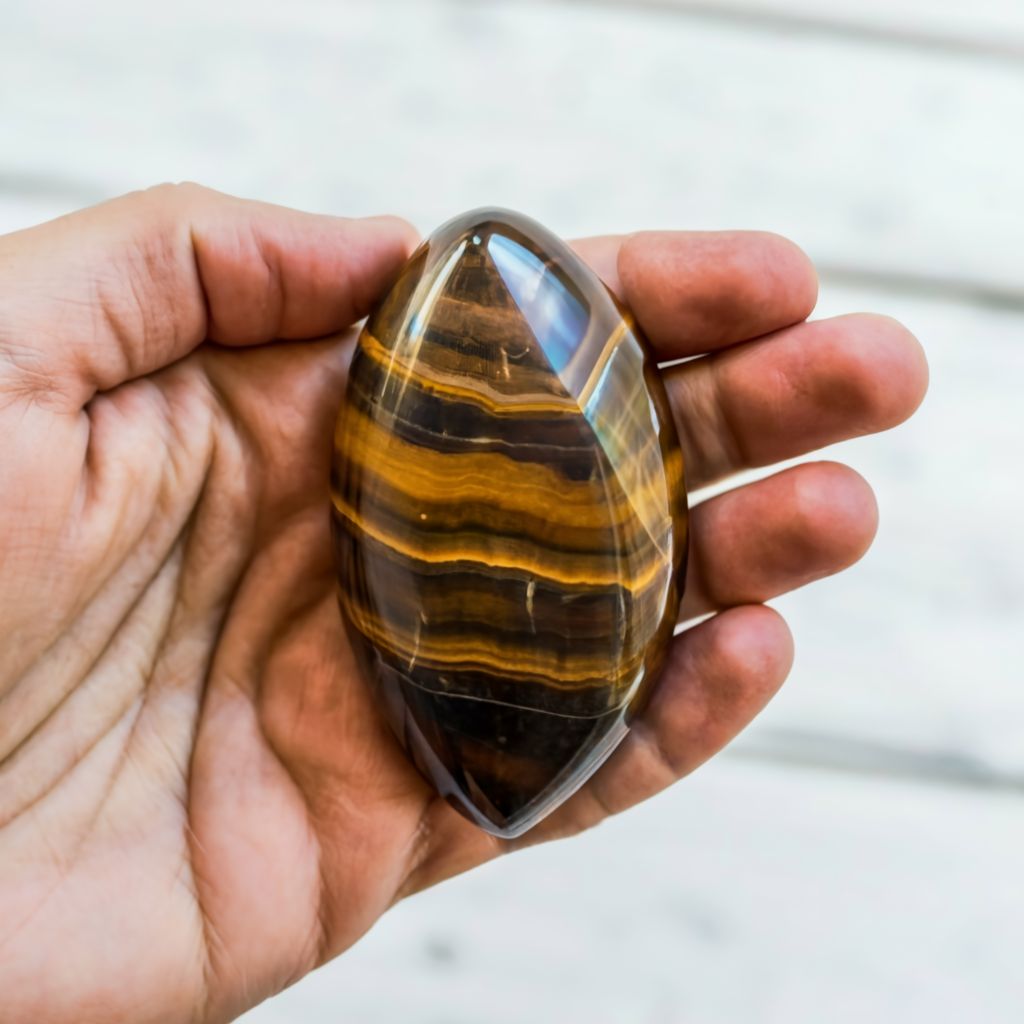
- Chatoyant Gemstone: Tiger’s eye is characterized by its chatoyancy, displaying a silky luster and a golden to red-brown color.
- Metamorphic Rock: Typically, tiger’s eye is found as a metamorphic rock, often with a rich golden hue.
- Quartz Group Member: Belonging to the quartz group, tiger’s eye and its blue counterpart, hawk’s eye, derive their lustrous appearance from the parallel intergrowth of quartz crystals and altered amphibole fibers.
- Formation: The silky appearance of tiger’s eye comes from the intergrowth of quartz and altered amphibole fibers, which have largely transformed into limonite.
- Pseudomorphous Replacement: Tiger’s eye is a classic example of pseudomorphous replacement, where silica replaces fibrous crocidolite (blue asbestos), resulting in its distinctive appearance.
- Hawk’s Eye Variant: A blue variant of tiger’s eye, known as hawk’s eye, exists. It is incompletely silicified and displays a blue hue.
Onyx Quartz:

- Chatoyant Gemstone: Onyx is a chatoyant gemstone renowned for its sleek, black appearance and striking bands of color.
- Formation: Onyx quartz forms in a similar manner to agate, developing within the cavities of volcanic or sedimentary rocks as a result of silica-rich solutions.
- Variety within Quartz Group: As a member of the quartz group, onyx exhibits a distinctive black color with alternating bands of white or other colors, creating a captivating contrast.
- Band Formation: The characteristic bands of onyx are formed through the layering of quartz and other minerals, resulting in its distinctive banded appearance.
- Metamorphic Origin: Onyx undergoes a metamorphic process where minerals permeate through rock cavities, depositing layers of quartz and other materials over time.
- Polishing and Carving: Onyx is highly valued for its elegant appearance and is commonly polished and carved into decorative items, jewelry, and ornamental objects.
- Color Scheme: While black is the most common color of onyx, it can also exhibit bands of white, brown, red, or other hues, depending on the mineral impurities present during its formation.
- Translucency: Onyx is typically translucent to opaque, with certain varieties displaying varying degrees of transparency depending on the quality and thickness of the specimen.
- Cultural Significance: Onyx has been treasured for its aesthetic appeal and perceived metaphysical properties throughout history, often used in jewelry and as protective amulets in various cultures around the world.
Jasper Quartz:
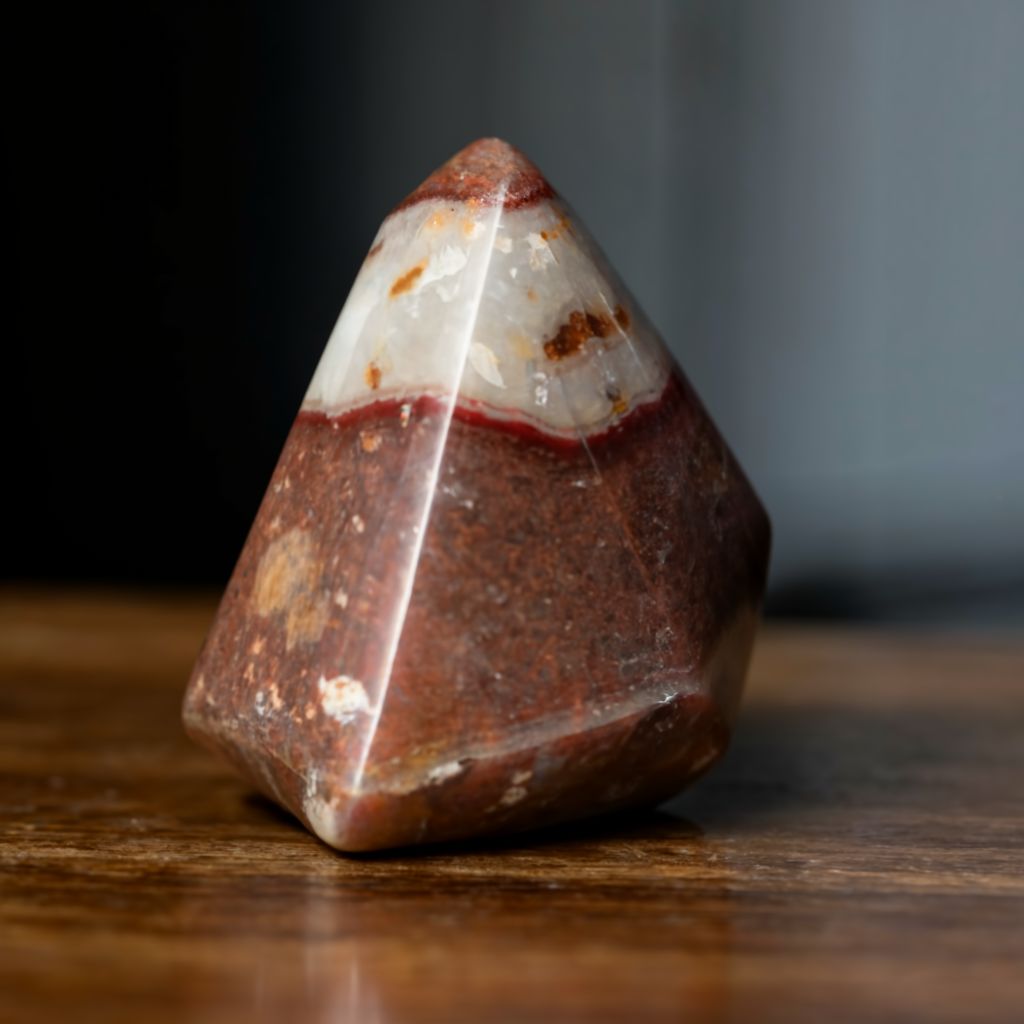
- Unique Gemstone: Jasper quartz is a distinctive variety of quartz known for its vibrant colors, intricate patterns, and opaque appearance.
- Formation: Jasper forms within sedimentary and igneous rocks through the deposition of silica-rich fluids, resulting in the distinctive patterns and colors characteristic of jasper.
- Quartz Variety: As a member of the quartz family, jasper exhibits the mineral’s typical crystalline structure but differs in its appearance due to the presence of various mineral impurities.
- Colorful Patterns: Jasper quartz showcases an array of colors and patterns, including swirling bands, speckles, and spots, created by the presence of different mineral inclusions during its formation.
- Metamorphic Processes: Jasper undergoes metamorphic processes over geological time, during which mineral-rich fluids infuse the rock, contributing to its unique coloration and patterns.
- Artistic and Decorative Use: Jasper’s striking appearance makes it a favored material for decorative objects, jewelry, and lapidary work, where its colorful patterns are showcased in various forms of adornment and art.
- Variety in Appearance: Jasper quartz can exhibit a wide range of colors, including red, yellow, green, brown, and blue, with each variety often named according to its predominant color or distinctive patterns.
- Symbolism and Cultural Significance: Throughout history, jasper has held cultural and metaphysical significance in different civilizations, often associated with protection, healing, and spiritual connection.
- Polishing and Carving: Jasper is commonly polished and carved into beads, cabochons, figurines, and other ornamental objects, allowing its unique patterns and colors to be displayed prominently.
- Geological Distribution: Jasper deposits can be found worldwide, with notable occurrences in regions such as the western United States, Australia, Brazil, India, and Madagascar, each producing jasper varieties with distinct characteristics.
Aventurine Quartz:
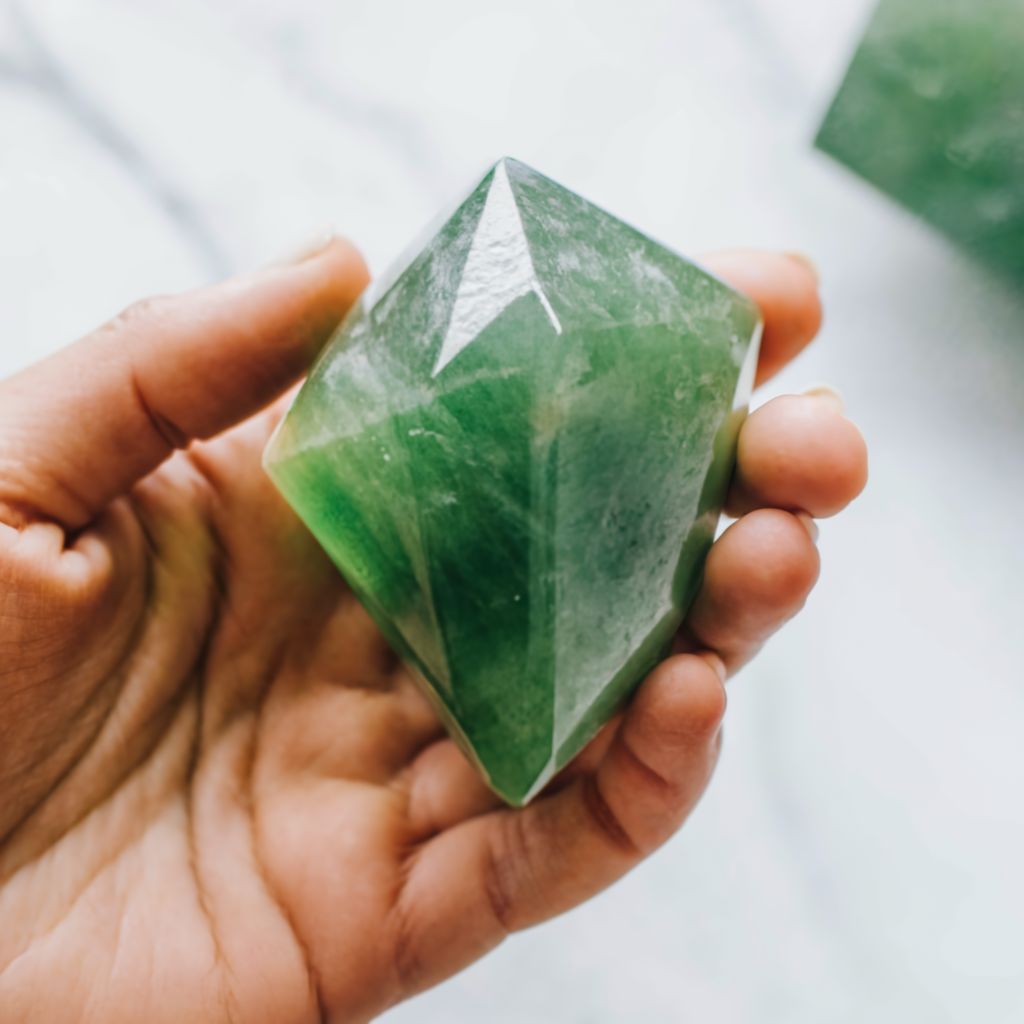
- Distinctive Gemstone: Aventurine quartz is a unique variety of quartz distinguished by its sparkling appearance and vibrant colorations, often exhibiting glittering metallic flecks known as “aventurescence.”
- Formation: Aventurine forms within igneous and metamorphic rocks through the crystallization of quartz-rich solutions containing inclusions of minerals such as mica, hematite, and fuchsite, which contribute to its characteristic shimmering effect.
- Quartz Composition: Aventurine quartz shares the same crystalline structure as other quartz varieties but differs in appearance due to the presence of specific mineral inclusions responsible for its unique color and sparkle.
- Aventurescent Properties: The shimmering effect in aventurine quartz, known as aventurescence, arises from the reflection of light off microscopic inclusions within the quartz, creating a captivating play of color and sparkle.
- Color Varieties: Aventurine quartz occurs in various colors, including green, blue, red, and orange, with green aventurine being the most common variety, often attributed to the presence of fuchsite or chlorite inclusions.
- Metaphysical Significance: Aventurine quartz is associated with luck, prosperity, and abundance in metaphysical practices, believed to attract positive energy and enhance personal growth and opportunity.
- Jewelry and Ornamental Use: Due to its attractive appearance and metaphysical properties, aventurine quartz is often crafted into beads, cabochons, and ornamental objects, making it a popular choice for jewelry and decorative items.
- Healing and Wellness: In holistic healing practices, aventurine quartz is believed to promote emotional balance, relieve stress, and enhance overall well-being, with green aventurine specifically associated with heart chakra healing and emotional healing.
- Geological Occurrence: Aventurine quartz deposits can be found in various parts of the world, including India, Brazil, Russia, and South Africa, where the presence of specific mineral inclusions and geological conditions contribute to its formation.
- Artistic Applications: Aventurine quartz’s unique appearance and metaphysical properties make it a favored material for lapidary work, sculpture, and decorative art, where its shimmering qualities are showcased in various artistic creations.
Amethyst Quartz:
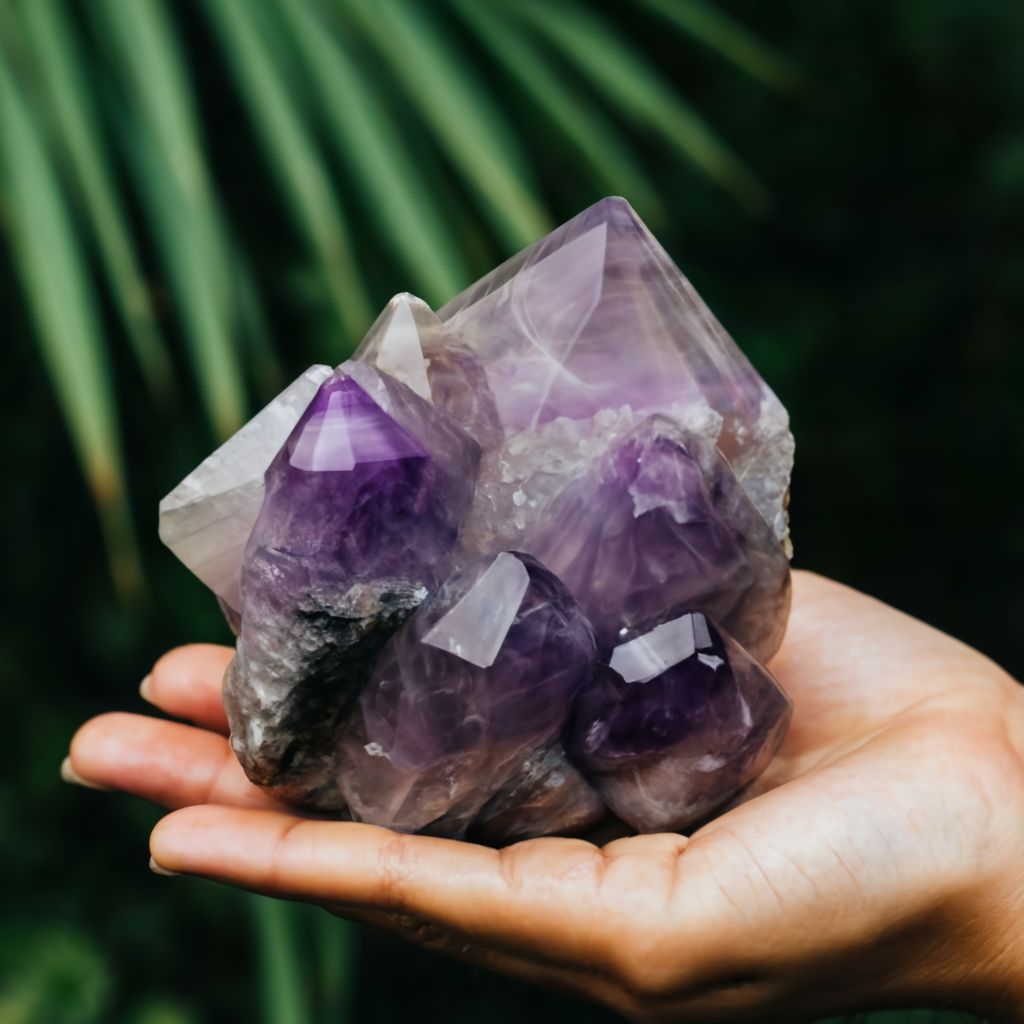
- Distinctive Gemstone: Amethyst quartz is a unique variety of quartz renowned for its purple coloration, ranging from pale lavender to deep violet hues, making it one of the most recognizable and prized gemstones.
- Formation: Amethyst quartz forms within igneous and metamorphic rocks through the crystallization of quartz-rich solutions containing traces of iron and aluminum, which impart its characteristic purple color.
- Quartz Composition: Structurally, amethyst quartz shares the same crystalline framework as other quartz varieties but distinguishes itself through the presence of iron impurities, which give rise to its distinctive purple hue.
- Color Variations: Amethyst quartz occurs in a spectrum of purple shades, influenced by factors such as iron concentration, geological conditions, and exposure to radiation, with deeper hues often considered more valuable.
- Metaphysical Significance: In metaphysical and spiritual practices, amethyst quartz is associated with clarity of mind, spiritual protection, and inner peace, believed to promote intuition, calmness, and connection to higher consciousness.
- Healing Properties: Amethyst quartz is revered for its healing properties, believed to alleviate stress, soothe emotional turmoil, and promote mental clarity, with its purple color symbolizing spiritual enlightenment and transformation.
- Jewelry and Ornamental Use: Due to its captivating color and metaphysical symbolism, amethyst quartz is a popular choice for jewelry, including rings, necklaces, and pendants, as well as ornamental objects and sculptures.
- Geological Occurrence: Amethyst quartz deposits are found worldwide, with notable sources including Brazil, Uruguay, Zambia, and Russia, where geological conditions conducive to quartz crystallization contribute to the formation of high-quality amethyst specimens.
- Historical Significance: Throughout history, amethyst quartz has been prized for its beauty and metaphysical properties, revered by ancient civilizations for its association with spirituality, protection, and royalty.
- Artistic and Cultural Significance: Amethyst quartz has inspired artists, jewelers, and craftsmen for centuries, featuring prominently in religious artifacts, royal regalia, and decorative art, symbolizing wisdom, enlightenment, and divine connection.
Rutilated Quartz:

- Unique Gemstone: Rutilated quartz is a distinctive variety of quartz distinguished by the presence of needle-like inclusions of golden, reddish, or black rutile, which create striking patterns within the transparent to translucent quartz matrix.
- Formation Process: Rutilated quartz forms when rutile, a mineral composed primarily of titanium dioxide, becomes trapped within the quartz during its crystallization process, resulting in the characteristic needle-like structures.
- Composition and Structure: Structurally, rutilated quartz shares the same crystalline framework as other quartz varieties but contains visible rutile inclusions, which vary in color and density, contributing to its aesthetic appeal and metaphysical properties.
- Appearance and Coloration: Rutilated quartz exhibits a translucent to transparent appearance with golden, reddish, or black rutile inclusions dispersed throughout the quartz matrix, creating intricate patterns and visual interest.
- Metaphysical Significance: In metaphysical and spiritual practices, rutilated quartz is revered for its powerful energy and transformative properties, believed to enhance spiritual growth, amplify intentions, and facilitate connection with higher realms.
- Healing Properties: Rutilated quartz is associated with cleansing and energizing the aura, promoting mental clarity, and dispelling negative energy and emotional blockages, making it a popular choice for meditation, healing, and spiritual practices.
- Jewelry and Ornamental Use: Due to its captivating appearance and metaphysical symbolism, rutilated quartz is frequently used in jewelry, including rings, earrings, and pendants, as well as ornamental objects and sculptures, admired for its unique beauty and energetic properties.
- Geological Occurrence: Rutilated quartz deposits are found in various locations worldwide, including Brazil, Madagascar, Australia, and the United States, where geological conditions conducive to quartz crystallization and rutile inclusion contribute to the formation of high-quality specimens.
- Artistic and Decorative Significance: Rutilated quartz has inspired artists, designers, and craftsmen to create unique jewelry pieces, sculptures, and decorative objects, admired for their aesthetic appeal and metaphysical significance, symbolizing spiritual transformation and enlightenment.
- Cultural and Historical Significance: Rutilated quartz has been revered by ancient civilizations for its mystical properties and connection to the divine, featuring prominently in religious rituals, ceremonial objects, and talismans, symbolizing protection, guidance, and spiritual awakening.
Citrine Quartz:
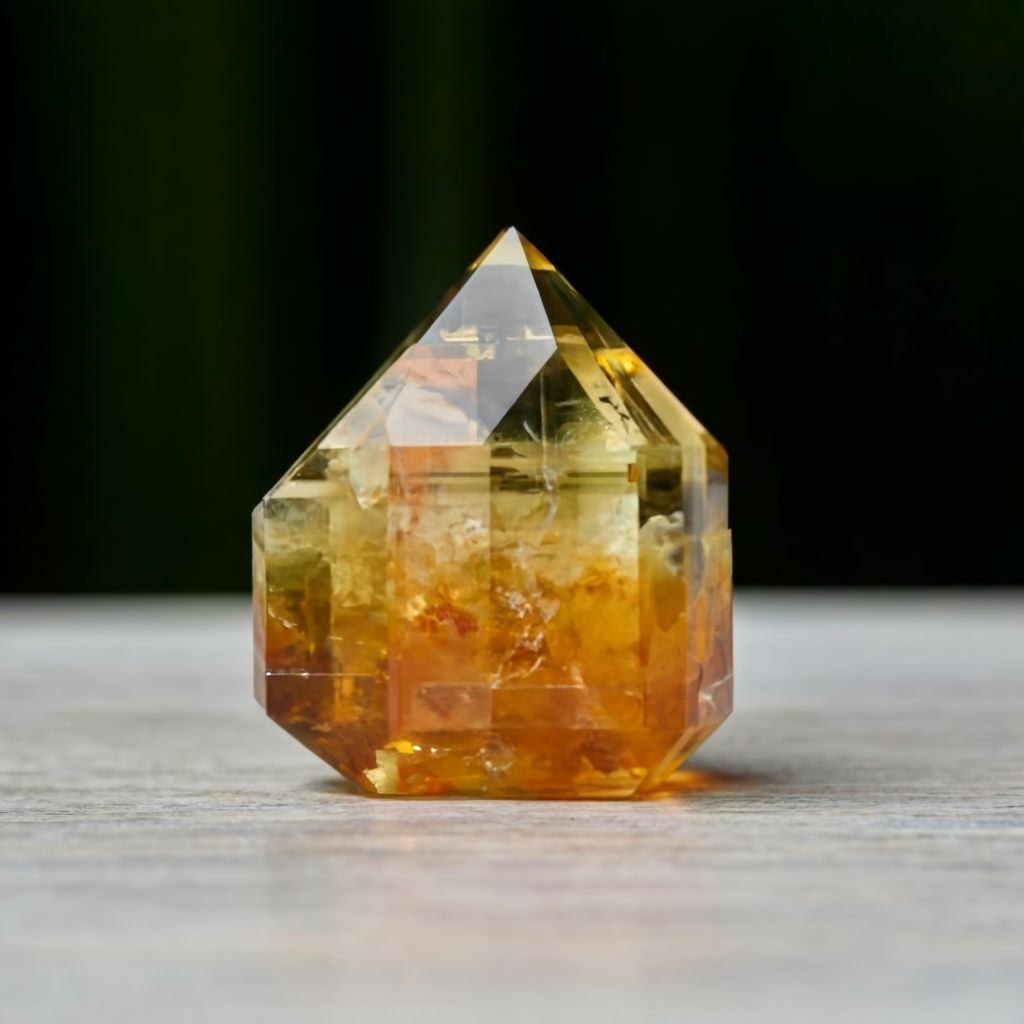
- Distinctive Gemstone: Citrine quartz is a variety of quartz renowned for its warm, sunny hues ranging from pale yellow to deep golden tones, often resembling the vibrant color of citrus fruits.
- Formation Process: Citrine quartz forms through the natural heating and irradiation of amethyst or smoky quartz, resulting in the transformation of their color from purple or brown to shades of yellow or golden-orange. Natural citrine is relatively rare, with most commercial citrine being heat-treated amethyst or smoky quartz.
- Composition and Structure: Structurally, citrine quartz shares the same crystalline framework as other quartz varieties but is distinguished by its characteristic yellow to golden coloration, caused by the presence of iron impurities within the crystal lattice.
- Appearance and Color Variation: Citrine quartz exhibits a transparent to translucent appearance with varying degrees of saturation and clarity, ranging from pale lemon yellow to deep amber hues, often displaying a radiant brilliance and internal clarity.
- Metaphysical Properties: In metaphysical and spiritual practices, citrine quartz is revered for its energizing and uplifting properties, believed to promote abundance, prosperity, and vitality, while dispelling negative energy and fostering creativity and optimism.
- Healing and Energizing: Citrine quartz is associated with cleansing and revitalizing the mind, body, and spirit, promoting mental clarity, emotional balance, and physical well-being, making it a popular choice for meditation, crystal healing, and energy work.
- Jewelry and Decorative Use: Due to its vibrant color and metaphysical significance, citrine quartz is frequently used in jewelry, including rings, necklaces, bracelets, and earrings, as well as decorative objects and ornaments, admired for its radiant beauty and positive energy.
- Geological Occurrence: Citrine quartz deposits are found in various geological settings worldwide, including Brazil, Bolivia, Madagascar, Russia, and the United States, where geological conditions conducive to quartz crystallization and iron impurities contribute to the formation of high-quality citrine specimens.
- Cultural and Symbolic Significance: Citrine quartz has been revered by cultures throughout history for its association with wealth, success, and prosperity, often symbolizing abundance, generosity, and good fortune, and featuring prominently in religious rituals, ceremonial objects, and talismans.
- Artistic and Fashion Influence: Citrine quartz has inspired artists, designers, and jewelers to create stunning jewelry pieces, sculptures, and decorative objects, celebrated for their vibrant color and metaphysical symbolism, symbolizing joy, vitality, and the radiant warmth of the sun.
Prasiolite Quartz:
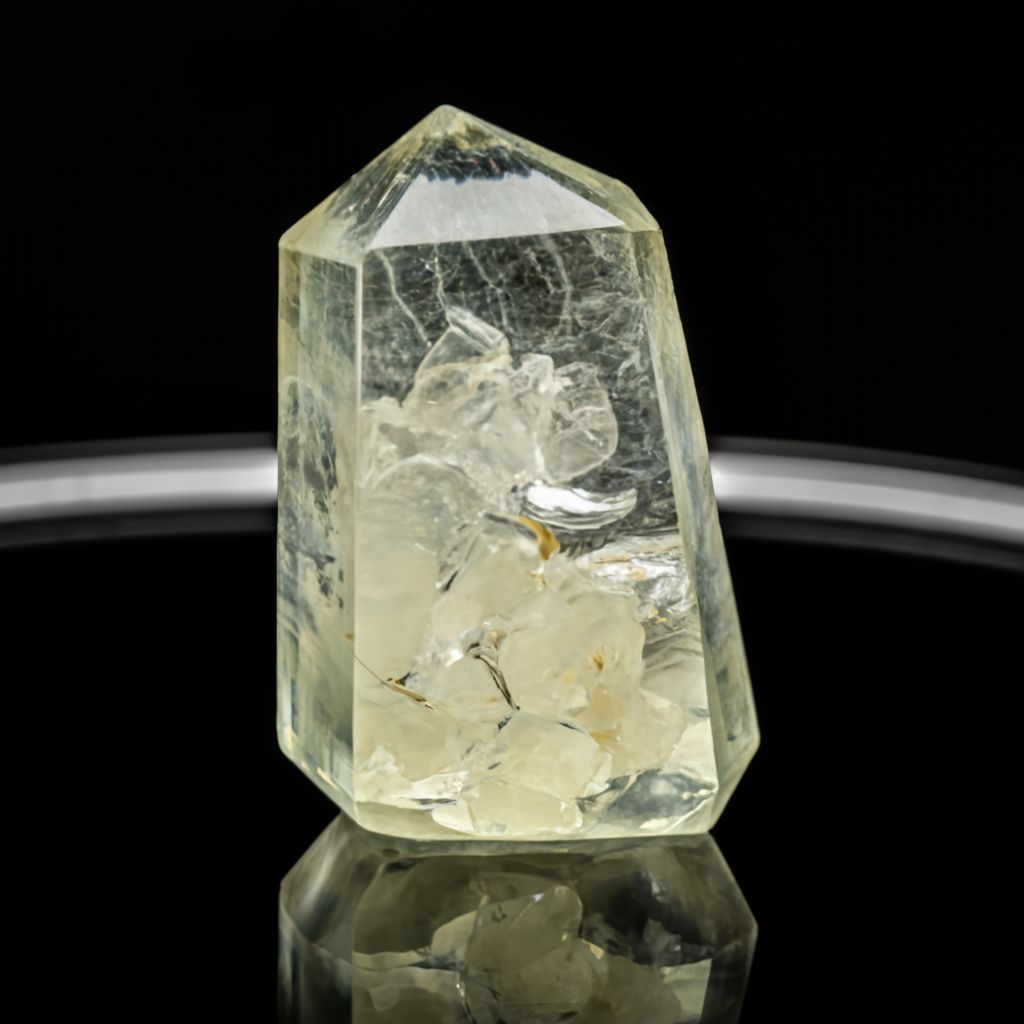
- Distinctive Gemstone: Prasiolite quartz, also known as green amethyst, is a unique variety of quartz prized for its delicate green hues, ranging from pale mint to deep olive tones, resembling the fresh color of spring foliage.
- Formation Process: Prasiolite quartz forms through the heating and irradiation of certain varieties of amethyst or yellow quartz, resulting in the transformation of their color from purple or yellow to shades of green. The process mimics natural geological conditions and is often enhanced through heat treatment.
- Composition and Structure: Structurally, prasiolite quartz shares the same crystalline framework as other quartz varieties but is distinguished by its characteristic green coloration, caused by the presence of iron impurities and natural irradiation within the crystal lattice.
- Appearance and Color Variation: Prasiolite quartz exhibits a transparent to translucent appearance with varying degrees of saturation and clarity, ranging from soft pastel green to deep forest hues, often displaying a subtle glow and inner radiance.
- Metaphysical Properties: In metaphysical and spiritual practices, prasiolite quartz is revered for its soothing and harmonizing properties, believed to promote emotional healing, spiritual growth, and inner peace, while facilitating connection with nature and the higher self.
- Healing and Balancing: Prasiolite quartz is associated with the heart chakra and is believed to support emotional healing, compassion, and forgiveness, fostering a sense of renewal, balance, and tranquility, making it a popular choice for meditation, energy healing, and spiritual alignment.
- Jewelry and Ornamental Use: Due to its serene color and metaphysical significance, prasiolite quartz is often used in jewelry, including rings, pendants, earrings, and bracelets, as well as decorative objects and ornaments, admired for its calming energy and natural beauty.
- Geological Occurrence: Prasiolite quartz deposits are found in various geological formations worldwide, including Brazil, Arizona, and Madagascar, where geological processes involving heat, pressure, and mineralization contribute to the formation of high-quality prasiolite specimens.
- Cultural and Symbolic Significance: Prasiolite quartz has been esteemed by cultures for its association with nature, renewal, and growth, often symbolizing vitality, abundance, and spiritual transformation, and featuring prominently in rituals, ceremonies, and talismans.
- Artistic and Fashion Influence: Prasiolite quartz has inspired artists, designers, and jewelers to create exquisite jewelry pieces, sculptures, and decorative accents, celebrated for their tranquil color and metaphysical symbolism, evoking the serenity and rejuvenation of lush green landscapes.
Rose Quartz:
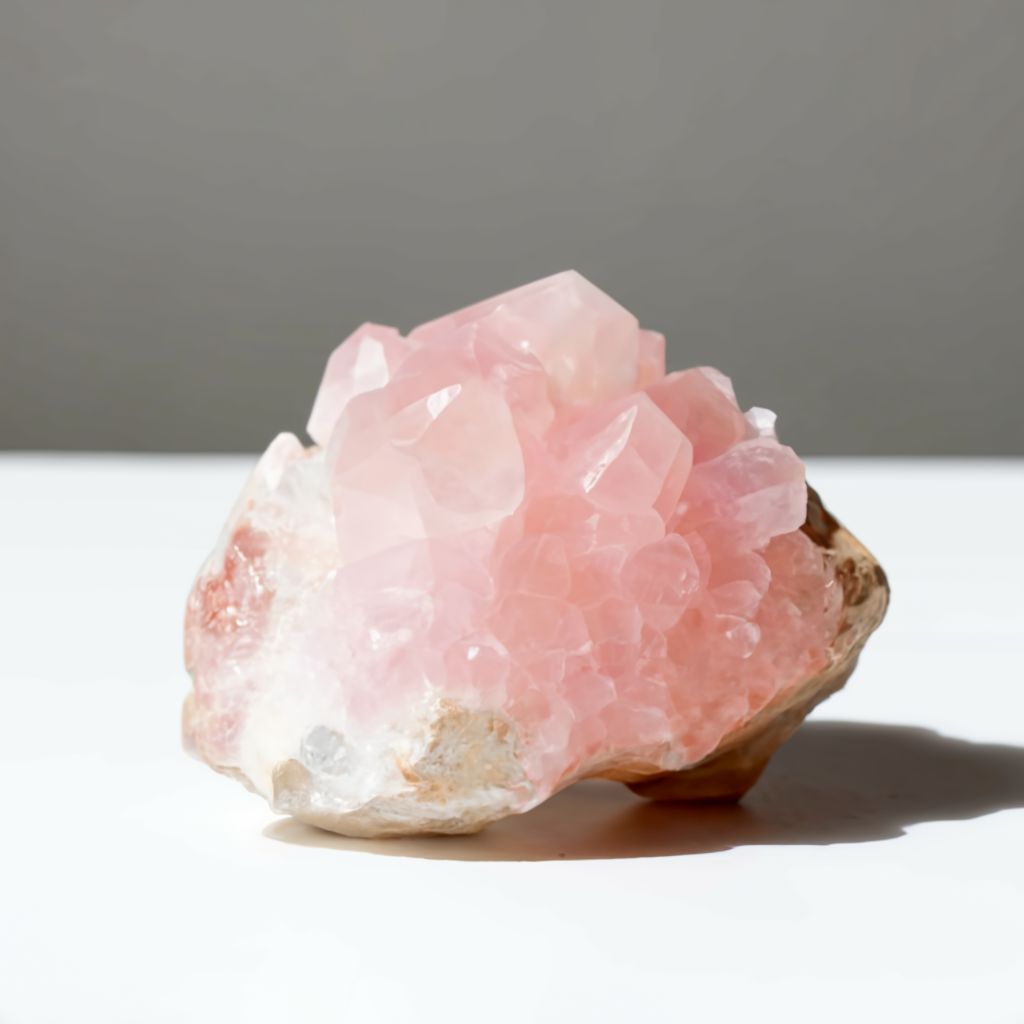
- Distinctive Gemstone: Rose quartz is a renowned variety of quartz esteemed for its delicate pink hues, ranging from soft pastel tones to deeper rosy shades, reminiscent of the gentle blush of a rose petal.
- Formation Process: Rose quartz forms within pegmatite veins and igneous rocks through the slow crystallization of magma enriched with silicon dioxide, iron, and titanium, resulting in its characteristic pink coloration. The color may be enhanced through heat treatment or irradiation.
- Composition and Structure: Structurally, rose quartz shares the same crystal lattice as other quartz varieties but is distinguished by its pink color, attributed to trace amounts of titanium, iron, or manganese impurities within the crystal structure.
- Appearance and Color Variation: Rose quartz typically exhibits a translucent to transparent appearance, with varying degrees of clarity and saturation in its pink coloration, ranging from pale blush to vivid pink hues, often showcasing a gentle luminescence and inner warmth.
- Metaphysical Properties: In metaphysical and spiritual practices, rose quartz is revered for its soothing and nurturing properties, believed to promote love, compassion, and emotional healing, while fostering harmony, self-acceptance, and forgiveness.
- Healing and Balancing: Rose quartz is associated with the heart chakra and is believed to facilitate emotional healing, intimacy, and trust, encouraging deep connections with oneself and others, and promoting inner peace, resilience, and serenity.
- Jewelry and Ornamental Use: Due to its soft pink color and metaphysical significance, rose quartz is a popular choice for jewelry, including rings, pendants, necklaces, bracelets, and beads, as well as decorative carvings, figurines, and ornaments, admired for its gentle energy and natural beauty.
- Geological Occurrence: Rose quartz deposits are found in various geological formations worldwide, including Brazil, Madagascar, South Africa, and the United States, where geological processes involving heat, pressure, and mineralization contribute to the formation of high-quality rose quartz specimens.
- Cultural and Symbolic Significance: Rose quartz has been revered by cultures for its association with love, compassion, and emotional healing, often symbolizing affection, tenderness, and romantic connection, and featuring prominently in rituals, ceremonies, and amulets.
- Artistic and Fashion Influence: Rose quartz has inspired artists, designers, and jewelers to create elegant and sentimental pieces of jewelry, sculptures, and decorative objects, celebrated for their gentle pink hues and metaphysical symbolism, evoking the beauty and warmth of love and friendship.
Milky Quartz:
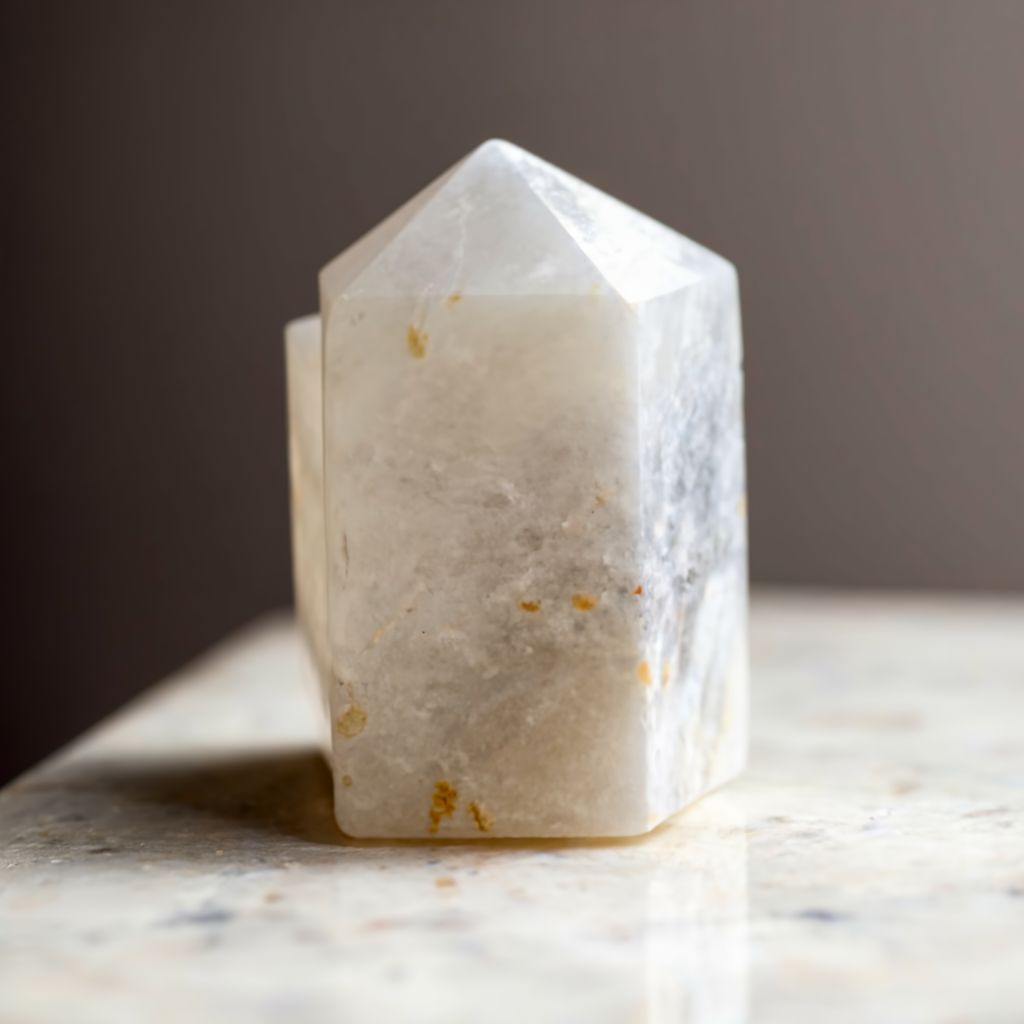
- Distinctive Appearance: Milky quartz is a variety of quartz known for its opaque, milky-white appearance, characterized by its clouded or hazy translucency, which diffuses light rather than transmitting it clearly like other quartz varieties.
- Formation Process: Milky quartz forms as a result of the presence of microscopic fluid inclusions, gas bubbles, or tiny crystals trapped within the quartz structure during its crystallization process, causing light scattering and opacity.
- Composition and Structure: Chemically, milky quartz shares the same composition as other quartz varieties, primarily consisting of silicon dioxide (SiO2). Its milky appearance is due to the presence of numerous tiny cavities and imperfections within the crystal lattice.
- Appearance and Color Variation: Milky quartz typically exhibits a milky-white to creamy appearance, with variations in opacity and translucency, ranging from nearly transparent to fully opaque. Its coloration may vary depending on the concentration and distribution of inclusions.
- Metaphysical Properties: In metaphysical beliefs, milky quartz is associated with purity, clarity, and inner harmony, believed to enhance spiritual awareness, clarity of thought, and emotional balance, while promoting tranquility and positive energy flow.
- Healing and Cleansing: Milky quartz is believed to have cleansing and purifying properties, both energetically and spiritually, helping to dispel negative energies, alleviate stress, and promote mental clarity, focus, and emotional well-being.
- Jewelry and Decorative Use: Despite its opaque appearance, milky quartz is occasionally used in jewelry and ornamental pieces, often fashioned into beads, cabochons, and carvings, appreciated for its unique appearance and metaphysical significance.
- Geological Occurrence: Milky quartz deposits are found in various geological settings worldwide, including granite and pegmatite veins, sedimentary rocks, and hydrothermal veins, where geological processes involving heat, pressure, and mineralization contribute to its formation.
- Cultural and Symbolic Significance: Milky quartz has symbolic associations with purity, innocence, and spiritual enlightenment across different cultures and traditions, often revered for its tranquil appearance and metaphysical properties.
- Artistic and Decorative Influence: Milky quartz has inspired artists, sculptors, and designers to incorporate its unique appearance and metaphysical symbolism into decorative objects, sculptures, and architectural elements, valued for its serene and ethereal aesthetic.
Chalcedony Quartz:
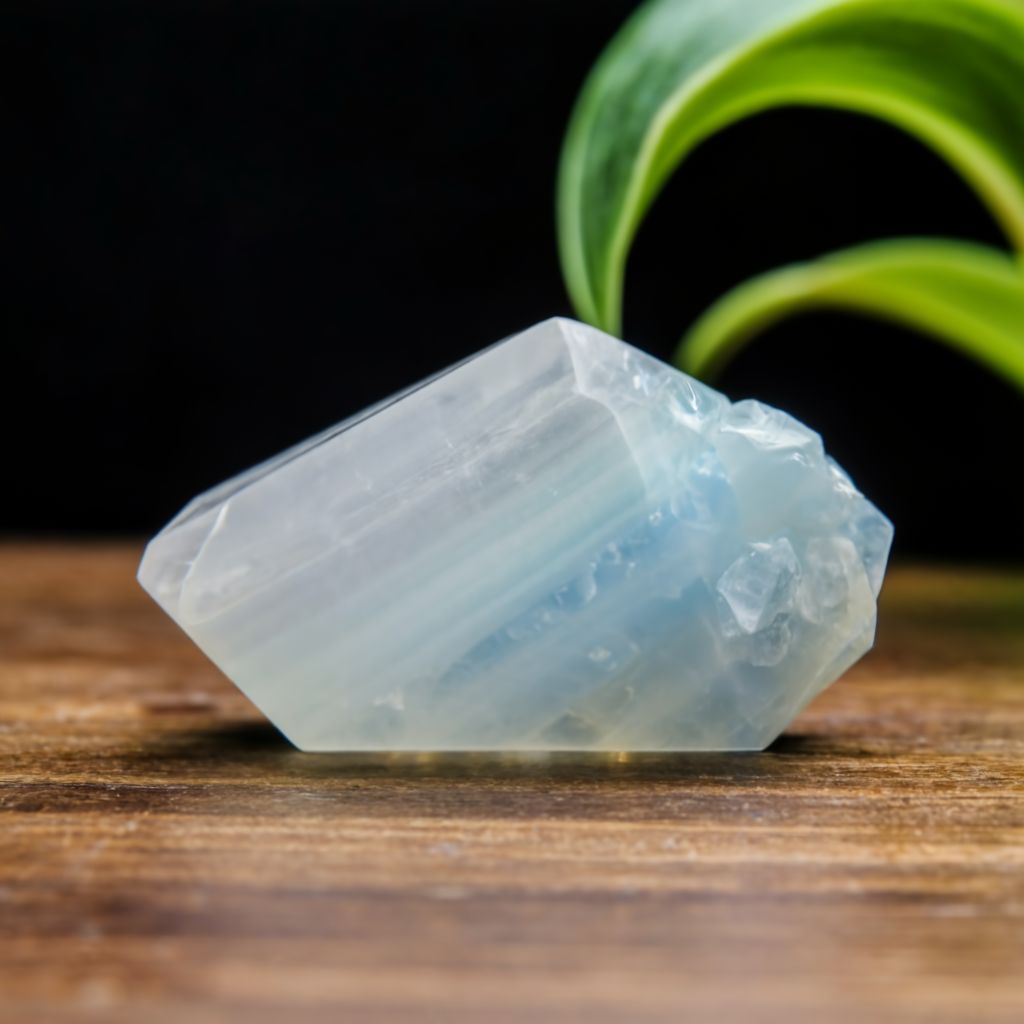
- Definition: Chalcedony is a cryptocrystalline variety of quartz, characterized by its fine-grained structure and waxy luster. It is composed of microscopic crystals of quartz and moganite.
- Formation Process: Chalcedony forms in a variety of geological environments, including sedimentary, igneous, and metamorphic rocks. It often occurs in cavities or veins where silica-rich solutions deposit and crystallize over time.
- Physical Characteristics: Chalcedony exhibits a wide range of colors, including white, gray, blue, pink, brown, and black. It may also display banding, translucency, or opacity, depending on impurities and structural variations.
- Metaphysical Properties: Chalcedony is associated with nurturing, harmony, and balance. It is believed to promote feelings of kindness, generosity, and goodwill while calming the mind and soothing emotions. Chalcedony is also thought to enhance communication and foster a sense of connection with others.
- Healing Properties: In holistic healing practices, chalcedony is believed to support overall well-being, both physically and emotionally. It is thought to alleviate stress, promote emotional stability, and encourage feelings of inner peace and contentment.
- Jewelry and Ornamental Use: Chalcedony is commonly used in jewelry making, carved ornaments, and decorative objects due to its attractive colors, smooth texture, and durability. It is often cut into cabochons, beads, and cameos for use in earrings, necklaces, bracelets, and pendants.
- Geological Occurrence: Chalcedony deposits are found worldwide, with notable sources including Brazil, India, Madagascar, and the United States. It forms in a variety of geological settings, such as volcanic rocks, limestone, and hydrothermal veins.
- Varieties: Chalcedony encompasses several well-known varieties, including agate, carnelian, onyx, and jasper, each distinguished by its unique color, pattern, and physical properties.
- Symbolic Significance: Throughout history, chalcedony has been revered for its symbolic associations with protection, harmony, and positive energy. It has been used in amulets, talismans, and spiritual artifacts to ward off negative influences and promote spiritual growth.
- Artistic Influence: Chalcedony’s diverse colors and patterns have inspired artists, designers, and lapidaries to create intricate carvings, intaglios, and sculptures, showcasing its natural beauty and artistic potential.
Carnelian Quartz:
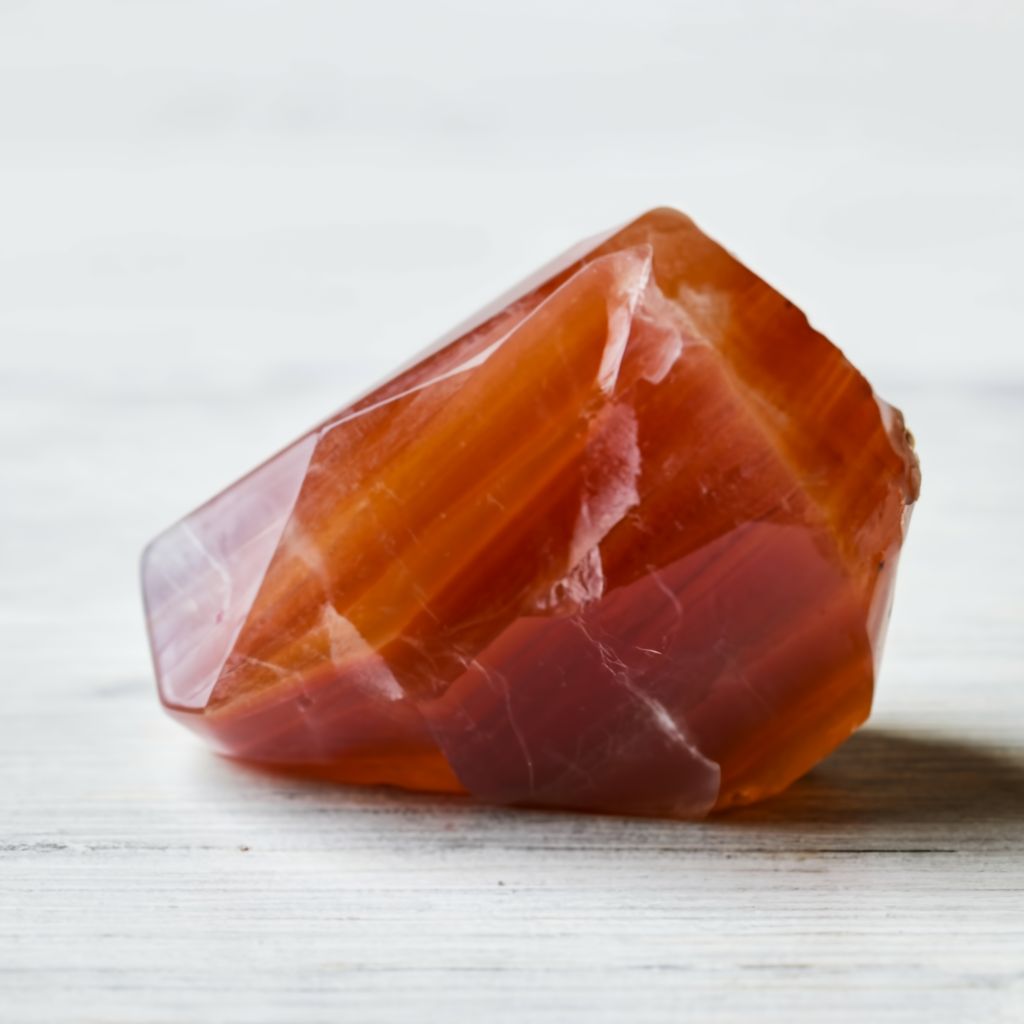
- Definition: Carnelian is a translucent to opaque variety of chalcedony quartz, known for its warm reddish-orange to brownish-red coloration. It derives its hues from iron oxide impurities.
- Formation Process: Carnelian forms through the deposition of silica-rich solutions in cavities or fractures within rocks. Over time, these solutions crystallize, forming the characteristic colors and patterns seen in carnelian.
- Physical Characteristics: Carnelian exhibits a range of colors, from deep red to orange and brownish-red. It often displays translucency and may feature banding or other patterns. Its smooth, waxy luster adds to its aesthetic appeal.
- Metaphysical Properties: Carnelian is associated with vitality, courage, and creativity. It is believed to stimulate the sacral chakra, enhancing feelings of passion, motivation, and confidence. Carnelian is also thought to promote physical vitality and emotional balance.
- Healing Properties: In alternative healing practices, carnelian is used to boost energy levels, improve circulation, and alleviate feelings of lethargy or apathy. It is also thought to support reproductive health and enhance fertility.
- Jewelry and Ornamental Use: Carnelian has been prized for centuries for its vibrant color and durability. It is commonly used in beadwork, cabochons, and cameos for jewelry such as necklaces, bracelets, and rings. Its rich tones add warmth and elegance to any piece.
- Geological Occurrence: Carnelian deposits are found in various regions around the world, including Brazil, India, Madagascar, and the United States. It often occurs in association with other quartz varieties and is commonly found in sedimentary and volcanic rocks.
- Symbolic Significance: Carnelian has long been associated with vitality, courage, and protection. In ancient civilizations, it was worn as a talisman to ward off negative energies and bring good fortune to the wearer. Its vibrant color symbolizes passion and creativity.
- Artistic Influence: Carnelian’s rich hues and smooth texture have inspired artisans and craftsmen to create intricate carvings, amulets, and seals throughout history. It has been used in engraved signet rings, amulets, and decorative objects, showcasing its timeless beauty and symbolic significance.
- Cultural and Historical Significance: Carnelian has played a significant role in various cultures and traditions, from ancient Egypt to medieval Europe. It was believed to have protective powers and was often used in religious ceremonies, rituals, and burial practices.
- Modern Applications: Today, carnelian remains a popular gemstone prized for its beauty and metaphysical properties. It is used in jewelry making, holistic healing, and decorative arts, continuing its legacy as a symbol of vitality and strength.
Smoky Quartz:
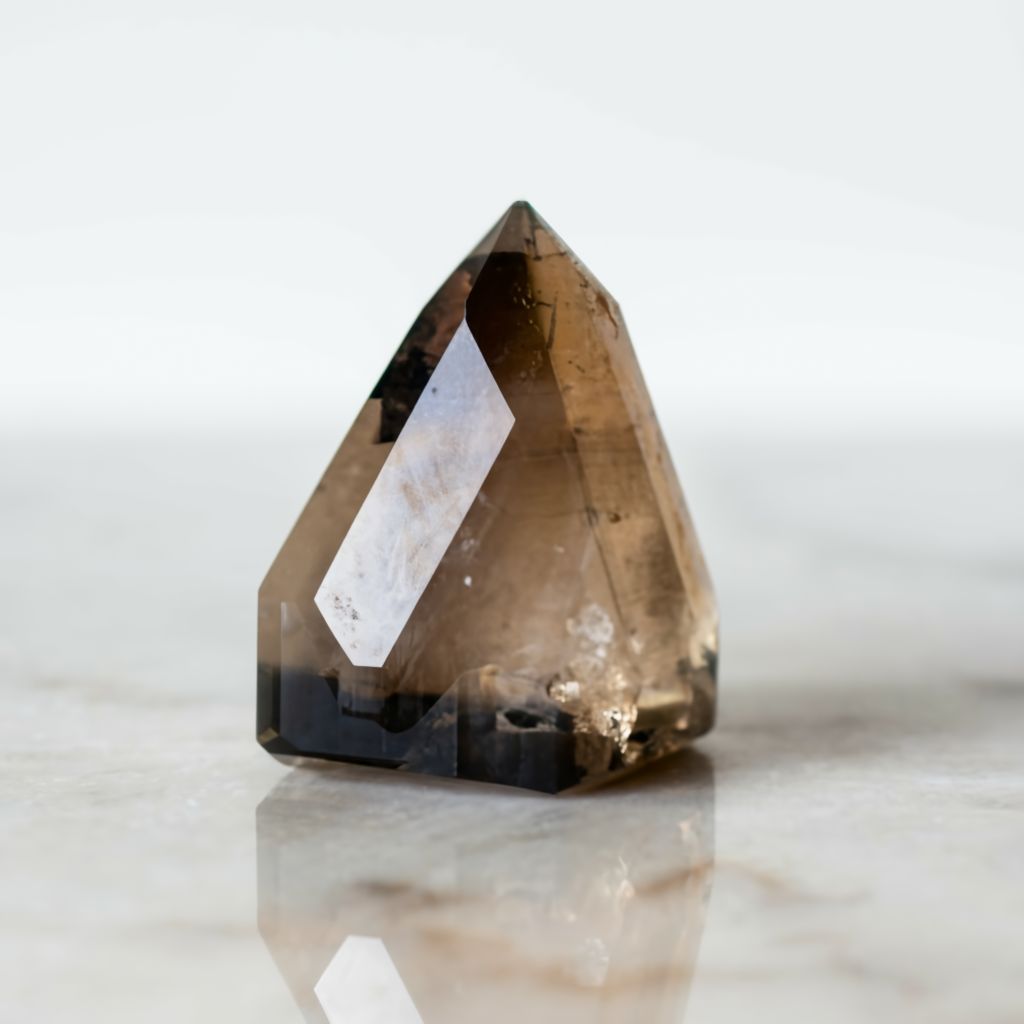
- Definition: Smoky quartz is a translucent to transparent variety of quartz known for its distinctive smoky brown to grayish coloration. The color results from natural radiation exposure within the Earth’s crust.
- Formation Process: Smoky quartz forms through the natural irradiation of colorless quartz crystals. The radiation exposure causes aluminum impurities to migrate within the crystal lattice, resulting in the characteristic brown or gray coloration.
- Physical Characteristics: Smoky quartz ranges in color from light grayish-brown to deep, almost black hues. It typically exhibits transparency or translucency and may feature a vitreous luster. Smoky quartz crystals can occur in various sizes, from small clusters to large individual specimens.
- Metaphysical Properties: Smoky quartz is associated with grounding, protection, and purification. It is believed to absorb and transmute negative energies, promoting emotional stability, and mental clarity. Smoky quartz is also thought to alleviate stress, anxiety, and depression.
- Healing Properties: In alternative healing practices, smoky quartz is used to cleanse and balance the aura, chakras, and energy field. It is believed to alleviate physical ailments such as headaches, insomnia, and fatigue. Smoky quartz is also thought to promote detoxification and vitality.
- Jewelry and Ornamental Use: Smoky quartz is popularly used in jewelry, particularly in rings, pendants, and earrings. Its earthy tones and versatile appearance make it a favorite choice for both men’s and women’s accessories. Smoky quartz is also used as decorative accents in sculptures, carvings, and home decor.
- Geological Occurrence: Smoky quartz is found in various geological settings, including granite pegmatites, hydrothermal veins, and metamorphic rocks. It occurs in regions with abundant quartz deposits, such as Brazil, Madagascar, the United States, and the Swiss Alps.
- Symbolic Significance: Smoky quartz symbolizes resilience, protection, and transformation. Its grounding properties are associated with stability and inner strength, making it a talisman for overcoming challenges and adversity. Smoky quartz is also linked to spiritual growth and the manifestation of one’s goals and aspirations.
- Cultural and Historical Significance: Throughout history, smoky quartz has been revered by different cultures for its mystical properties. Ancient civilizations believed it to be a stone of endurance and endurance, often using it in ceremonial rituals and protective amulets. In modern times, smoky quartz continues to be valued for its beauty and metaphysical properties.
- Modern Applications: Smoky quartz remains a sought-after gemstone in the jewelry industry and is also used in alternative healing practices and spiritual rituals. Its calming energy and protective qualities make it a popular choice for individuals seeking balance, clarity, and resilience in their lives.
Mtorolite Quartz:
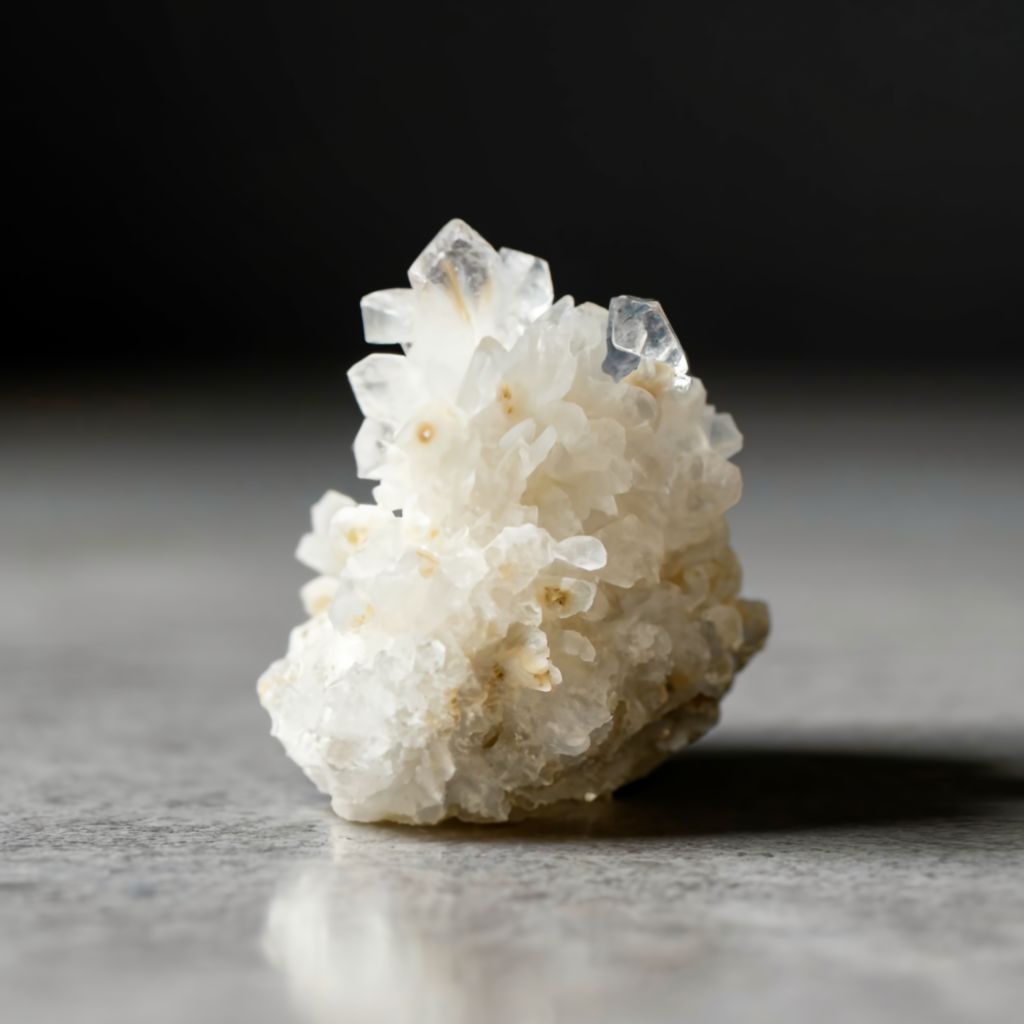
- Definition: Mtorolite quartz, also known as chrome chalcedony or chrome green quartz, is a variety of chalcedony quartz that features a distinct green coloration attributed to the presence of chromium and other trace minerals.
- Formation Process: Mtorolite quartz forms through the deposition of chalcedony within cavities or fractures in rocks, often in association with chromium-rich minerals. The green coloration is the result of chromium impurities within the quartz matrix.
- Physical Characteristics: Mtorolite quartz exhibits a vibrant green hue ranging from light to dark shades. It typically displays a waxy to vitreous luster and may have a translucent to opaque appearance. The green color is uniform and can be intense, resembling the color of emerald or jade.
- Metaphysical Properties: Mtorolite quartz is associated with healing, growth, and renewal. Its green color symbolizes vitality, abundance, and the natural world. Mtorolite quartz is believed to promote emotional balance, prosperity, and harmonious relationships.
- Healing Properties: In metaphysical practices, mtorolite quartz is used to support physical healing and rejuvenation. It is thought to enhance the immune system, detoxify the body, and alleviate symptoms of stress and fatigue. Mtorolite quartz is also believed to promote spiritual growth and inner transformation.
- Jewelry and Ornamental Use: Mtorolite quartz is valued for its rarity and distinctive color, making it a prized gemstone for jewelry and ornamental purposes. It is often cut into cabochons, beads, and polished stones for use in rings, pendants, earrings, and bracelets.
- Geological Occurrence: Mtorolite quartz is primarily found in regions with chromium-rich deposits, such as Zimbabwe and South Africa. It occurs in association with metamorphic rocks, particularly in areas where hydrothermal activity has altered the surrounding minerals.
- Symbolic Significance: Mtorolite quartz symbolizes renewal, vitality, and harmony with nature. Its green color reflects the lushness of vegetation and the regenerative powers of the natural world. Mtorolite quartz is associated with growth, abundance, and the cycles of life.
- Cultural and Historical Significance: Mtorolite quartz has been revered by indigenous cultures for its healing properties and connection to the earth. It has been used in ceremonial rituals, talismans, and amulets to promote vitality, prosperity, and spiritual well-being.
- Modern Applications: Mtorolite quartz remains a sought-after gemstone among collectors and enthusiasts for its unique color and metaphysical properties. It is used in jewelry, lapidary arts, and crystal healing practices to harness its energizing and balancing qualities.
Chrysoprase Quartz:
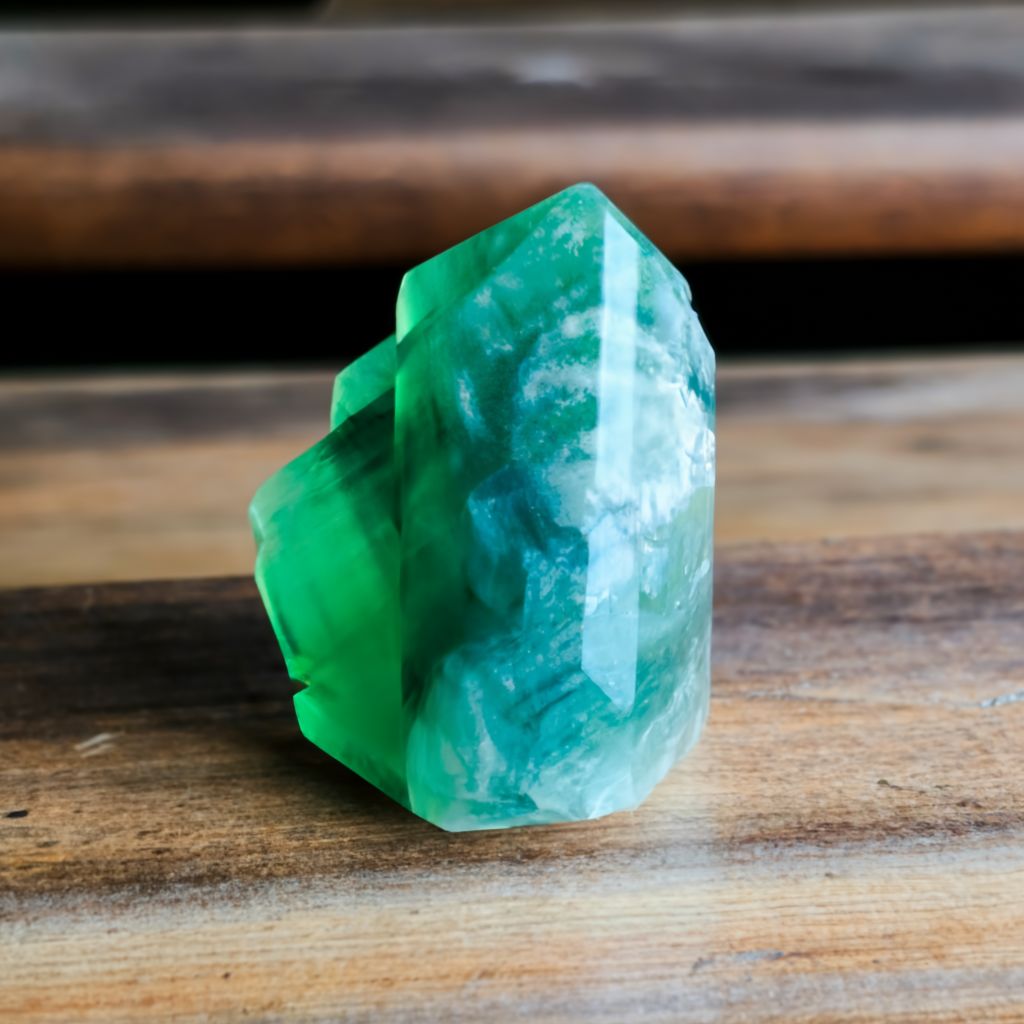
- Definition: Chrysoprase quartz is a variety of chalcedony quartz characterized by its distinct apple-green color, which is attributed to the presence of nickel impurities. It is a type of cryptocrystalline quartz.
- Formation Process: Chrysoprase quartz forms through the deposition of chalcedony within cavities or fractures in rocks, often in association with nickel-rich minerals. The green coloration is the result of nickel impurities within the quartz matrix.
- Physical Characteristics: Chrysoprase quartz exhibits a vibrant apple-green hue ranging from light to dark shades. It typically displays a waxy to vitreous luster and may have a translucent to opaque appearance. The green color is uniform and can be intense, resembling the color of fresh spring foliage.
- Metaphysical Properties: Chrysoprase quartz is associated with abundance, growth, and emotional balance. Its green color symbolizes renewal, vitality, and prosperity. Chrysoprase quartz is believed to promote healing, compassion, and inner harmony.
- Healing Properties: In metaphysical practices, chrysoprase quartz is used to support physical well-being and emotional healing. It is thought to enhance the immune system, alleviate stress, and promote a sense of peace and contentment. Chrysoprase quartz is also believed to stimulate creativity and intuition.
- Jewelry and Ornamental Use: Chrysoprase quartz is prized for its attractive green color and is often used in jewelry and ornamental pieces. It is cut into cabochons, beads, and polished stones for use in rings, pendants, earrings, and bracelets. Chrysoprase quartz is also carved into figurines and decorative objects.
- Geological Occurrence: Chrysoprase quartz is primarily found in regions with nickel-rich deposits, such as Australia, Russia, Brazil, and the United States. It occurs in association with metamorphic rocks, particularly in areas where hydrothermal activity has altered the surrounding minerals.
- Symbolic Significance: Chrysoprase quartz symbolizes growth, renewal, and prosperity. Its green color reflects the vitality of nature and the abundance of life. Chrysoprase quartz is associated with fertility, abundance, and the cycles of growth and renewal.
- Cultural and Historical Significance: Chrysoprase quartz has been revered by ancient cultures for its healing properties and connection to the natural world. It has been used in jewelry, talismans, and amulets to promote health, prosperity, and spiritual well-being.
- Modern Applications: Chrysoprase quartz remains a popular gemstone among collectors and jewelry enthusiasts for its unique color and metaphysical properties. It is used in jewelry-making, lapidary arts, and crystal healing practices to harness its rejuvenating and balancing energies.
Ferruginous Quartz:
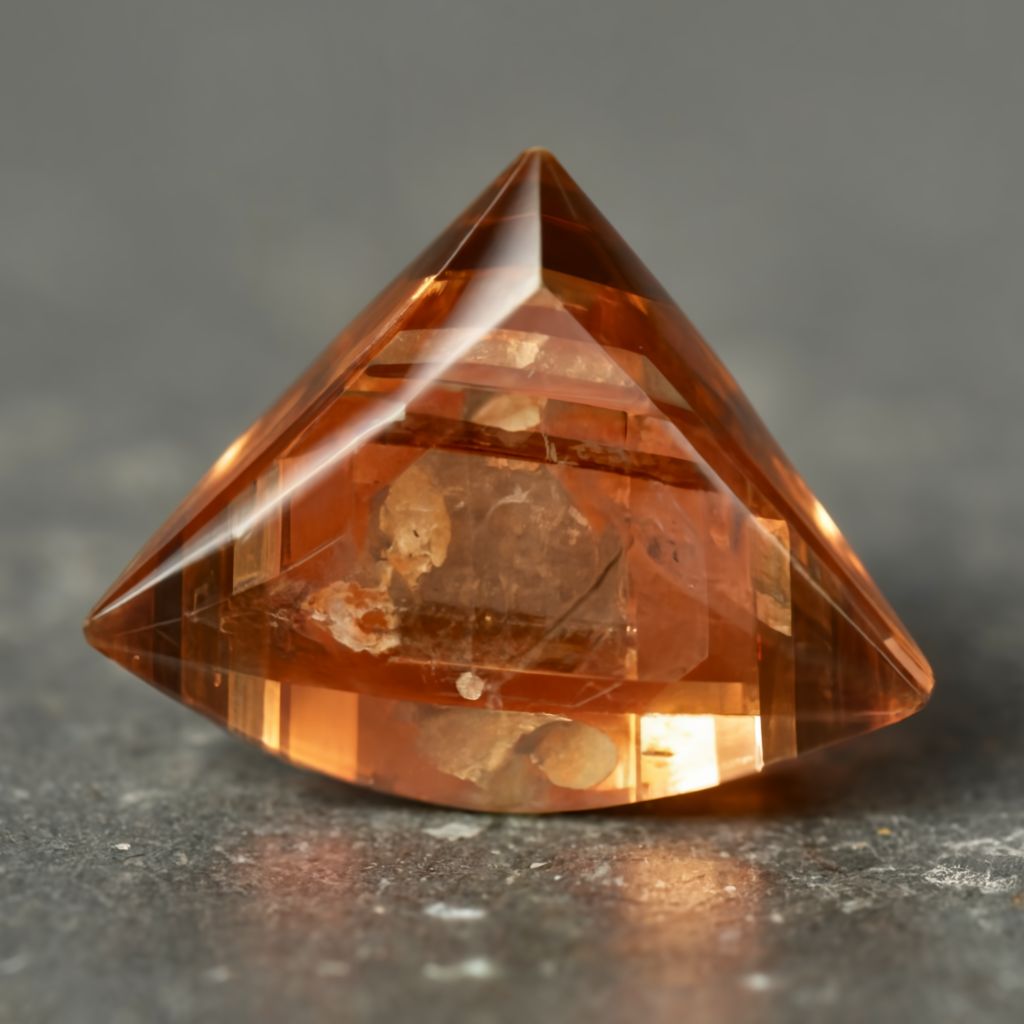
- Definition: Ferruginous quartz, also known as hematoid quartz or ferruginous quartzite, is a type of quartz characterized by the presence of iron oxide inclusions, typically hematite. These inclusions impart reddish-brown hues to the quartz matrix, creating unique patterns and textures.
- Formation Process: Ferruginous quartz forms when hematite, an iron oxide mineral, becomes included within quartz during the crystallization process. The presence of iron oxides results in the distinctive reddish-brown coloration observed in ferruginous quartz specimens.
- Physical Characteristics: Ferruginous quartz exhibits a range of reddish-brown colors, often with translucent to opaque clarity. The iron oxide inclusions may appear as fine streaks, patches, or dendritic patterns within the quartz matrix. The stone may display a vitreous to dull luster, depending on its composition and surface characteristics.
- Metaphysical Properties: Ferruginous quartz is believed to possess grounding and stabilizing energies, making it ideal for promoting strength, courage, and resilience. It is associated with the root chakra and is thought to enhance feelings of security, stability, and vitality.
- Healing Properties: In metaphysical practices, ferruginous quartz is used to support physical vitality, improve circulation, and boost energy levels. It is believed to stimulate the flow of life force energy throughout the body and promote overall well-being. Ferruginous quartz is also thought to aid in overcoming challenges and fostering inner strength.
- Jewelry and Ornamental Use: Ferruginous quartz is often used in jewelry and lapidary arts to create unique and visually striking pieces. It is fashioned into cabochons, beads, and faceted gemstones for use in rings, pendants, earrings, and other ornamental items. Ferruginous quartz is valued for its earthy colors and distinctive patterns, making it a popular choice among jewelry enthusiasts.
- Geological Occurrence: Ferruginous quartz is commonly found in regions where quartz-rich rocks undergo metamorphism or hydrothermal alteration in the presence of iron-bearing fluids. It occurs in various geological settings, including metamorphic schists, gneisses, and hydrothermal veins.
- Symbolic Significance: Ferruginous quartz symbolizes strength, resilience, and vitality. Its rich reddish-brown hues evoke feelings of groundedness and connection to the Earth. Ferruginous quartz is associated with courage, endurance, and the ability to overcome obstacles.
- Cultural and Historical Significance: Throughout history, ferruginous quartz has been revered for its protective and empowering qualities. It has been used by ancient cultures for amulets, talismans, and ceremonial objects associated with strength, vitality, and resilience.
- Modern Applications: Ferruginous quartz continues to be valued for its aesthetic appeal and metaphysical properties in modern times. It is used in jewelry-making, crystal healing practices, and decorative arts to harness its grounding and revitalizing energies.
Prase Quartz:
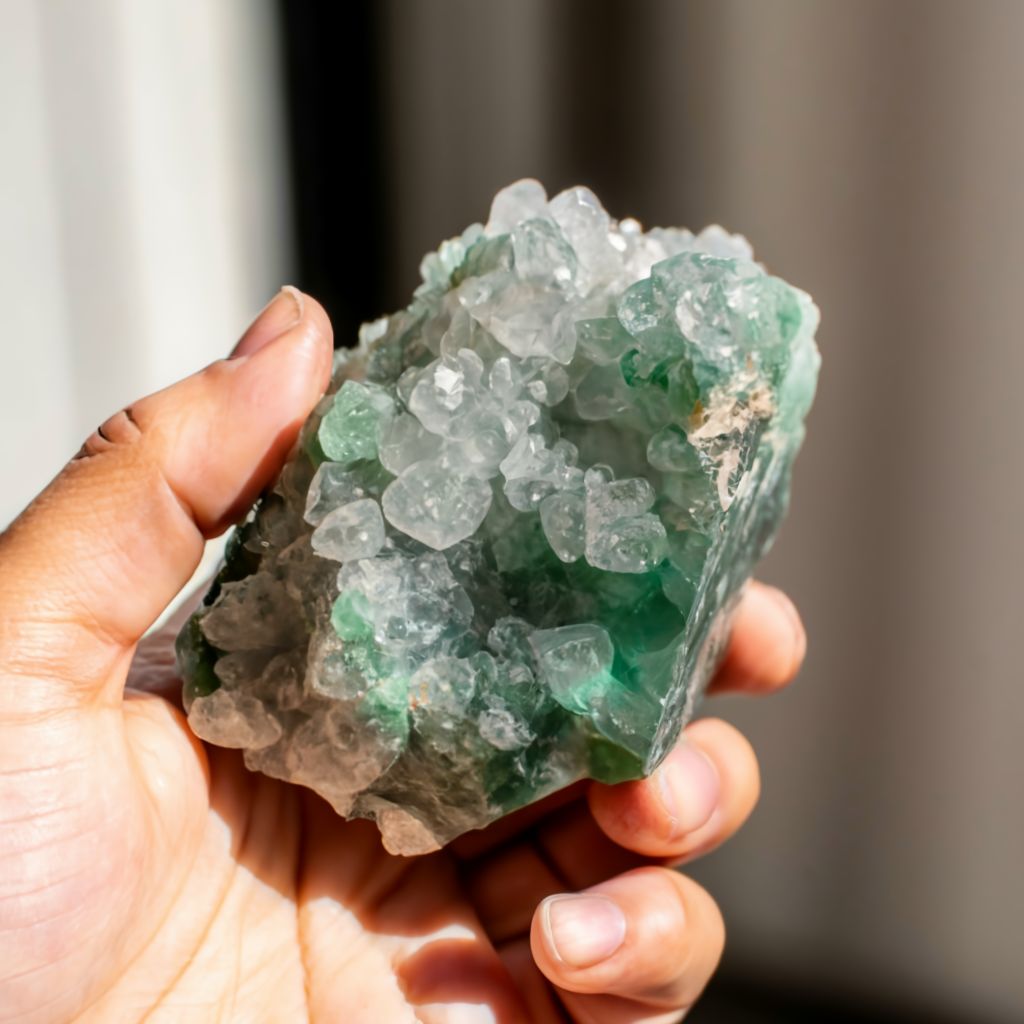
- Definition: Prase quartz, also known as green quartz or prasiolite, is a variety of quartz characterized by its green coloration, which is attributed to the presence of microscopic inclusions of chlorite, actinolite, or other minerals. It is valued for its soothing green hues and is often used in jewelry and decorative objects.
- Formation Process: Prase quartz forms when quartz crystals incorporate small inclusions of chlorite, actinolite, or other green-colored minerals during their growth. These inclusions impart the distinctive green color to the quartz matrix, creating prase quartz specimens.
- Physical Characteristics: Prase quartz typically exhibits shades of green ranging from pale mint to deep forest green. The color intensity and distribution of inclusions within the quartz matrix may vary, resulting in unique patterns and textures. Prase quartz may display a vitreous to greasy luster and is often transparent to translucent.
- Metaphysical Properties: Prase quartz is associated with healing, growth, and renewal. It is believed to resonate with the heart chakra, promoting emotional balance, compassion, and harmony. Prase quartz is thought to facilitate spiritual growth, inner peace, and connection with nature.
- Healing Properties: In metaphysical practices, prase quartz is used to promote physical health, vitality, and rejuvenation. It is believed to support the immune system, detoxify the body, and alleviate stress and anxiety. Prase quartz is also thought to enhance fertility and promote overall well-being.
- Jewelry and Ornamental Use: Prase quartz is prized for its calming green color and is often used in jewelry-making and lapidary arts. It is fashioned into cabochons, beads, and faceted gemstones for use in rings, necklaces, earrings, and bracelets. Prase quartz jewelry is cherished for its natural beauty and tranquil energy.
- Geological Occurrence: Prase quartz is found in regions where quartz-rich rocks undergo metamorphism or hydrothermal alteration in the presence of green-colored minerals such as chlorite or actinolite. It occurs in various geological settings, including metamorphic schists, gneisses, and hydrothermal veins.
- Symbolic Significance: Prase quartz symbolizes growth, healing, and renewal. Its green color reflects the vitality of nature and the cyclical rhythms of life. Prase quartz is associated with transformation, abundance, and the harmonious balance between the physical and spiritual realms.
- Cultural and Historical Significance: Throughout history, prase quartz has been revered for its healing properties and connection to nature. It has been used by ancient cultures for talismans, amulets, and ceremonial objects associated with fertility, prosperity, and spiritual growth.
- Modern Applications: Prase quartz continues to be valued for its aesthetic appeal and metaphysical properties in modern times. It is used in jewelry-making, crystal healing practices, and decorative arts to harness its calming and revitalizing energies. Prase quartz is also used in architectural and interior design to create serene and harmonious environments.
Heliotrope Quartz:
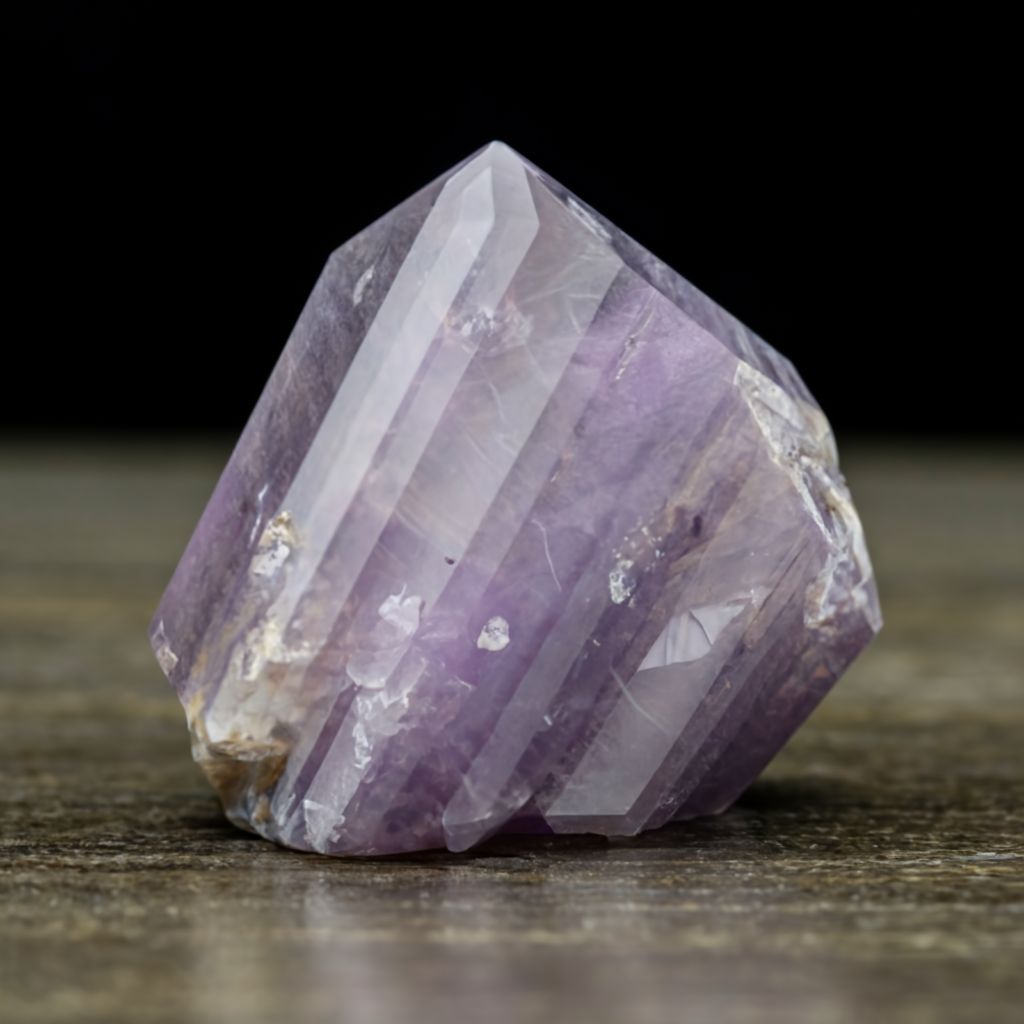
- Definition: Heliotrope quartz, also known as bloodstone, is a variety of quartz characterized by its dark green color with red or brownish spots. It derives its name from the appearance of blood spots on a green surface, resembling drops of blood on a stone. Heliotrope quartz is valued for its unique coloration and is often used in jewelry and lapidary work.
- Formation Process: Heliotrope quartz forms when dark green jasper or chalcedony is intermixed with red to brownish iron oxide inclusions, primarily hematite. These inclusions create the distinctive spotted appearance characteristic of bloodstone. The stone may also contain other minerals such as chlorite and epidote, contributing to its overall composition.
- Physical Characteristics: Heliotrope quartz typically exhibits a dark green base color, often resembling the color of foliage. It is adorned with red to brownish spots or streaks, resembling splatters or droplets of blood. The stone has a smooth to waxy luster and may display a translucent to opaque appearance. Heliotrope quartz is commonly fashioned into cabochons and beads for use in jewelry.
- Metaphysical Properties: Heliotrope quartz is associated with vitality, strength, and courage. In metaphysical beliefs, it is considered a powerful healing stone that promotes physical health, vitality, and well-being. Heliotrope quartz is believed to stimulate the flow of life force energy throughout the body and enhance overall vitality.
- Healing Properties: In crystal healing practices, heliotrope quartz is used to purify and strengthen the blood, improve circulation, and support the immune system. It is believed to alleviate stress, balance emotions, and promote mental clarity and focus. Heliotrope quartz is also thought to enhance courage, determination, and perseverance in overcoming challenges.
- Jewelry and Ornamental Use: Heliotrope quartz is prized for its distinctive appearance and is often used in jewelry-making and lapidary arts. It is fashioned into cabochons, beads, and carvings for use in rings, pendants, earrings, and bracelets. Heliotrope quartz jewelry is cherished for its unique coloration and symbolic significance.
- Geological Occurrence: Heliotrope quartz is primarily found in metamorphic rocks, especially those associated with hydrothermal veins and deposits. It occurs in regions where silica-rich fluids interact with iron-rich minerals under conditions of elevated temperature and pressure. Heliotrope quartz deposits are found in various locations around the world, including India, Brazil, Australia, and the United States.
- Symbolic Significance: Heliotrope quartz symbolizes courage, vitality, and resilience. Its association with blood and strength has led to its historical use as a protective talisman and amulet against negative energies and harm. Heliotrope quartz is regarded as a stone of vitality and endurance, empowering individuals to overcome obstacles and achieve their goals.
- Cultural and Historical Significance: Heliotrope quartz has a rich history and has been revered by ancient civilizations for its mystical properties. It was used by warriors and soldiers as a protective amulet in battle and was believed to impart courage and strength. In religious and spiritual practices, heliotrope quartz was associated with healing, purification, and renewal.
- Modern Applications: Today, heliotrope quartz continues to be valued for its aesthetic appeal and metaphysical properties. It is used in jewelry-making, crystal healing practices, and decorative arts to harness its protective and energizing energies. Heliotrope quartz is also used in architectural and interior design to create a sense of strength and vitality in living spaces.
Sard Quartz:

- Definition: Sard quartz is a variety of quartz characterized by its reddish-brown to brownish-red coloration, resembling the hue of sard stone. It is prized for its warm and earthy tones, making it a popular choice for jewelry and ornamental purposes.
- Formation Process: Sard quartz forms through the inclusion of iron oxide minerals within the quartz crystal lattice during its growth process. The presence of iron oxide impurities imparts the distinctive reddish-brown color to the quartz. Over time, geological processes such as pressure and heat contribute to the formation of sard quartz.
- Physical Characteristics: Sard quartz typically exhibits a translucent to opaque appearance with a rich reddish-brown color. The quartz may display varying degrees of transparency, with some specimens featuring semi-translucent qualities. Sard quartz often showcases a vitreous to resinous luster, adding to its visual appeal.
- Metaphysical Properties: In metaphysical beliefs, sard quartz is associated with grounding, stability, and vitality. It is believed to resonate with the root chakra, promoting feelings of security, strength, and courage. Sard quartz is thought to provide a sense of stability during times of change and transition, helping individuals feel more grounded and centered.
- Healing Properties: Sard quartz is used in crystal healing practices to enhance physical vitality, stamina, and resilience. It is believed to stimulate the flow of life force energy throughout the body, promoting overall well-being and vitality. Sard quartz is also thought to support emotional healing and balance, helping individuals overcome feelings of insecurity or instability.
- Jewelry and Ornamental Use: Sard quartz is highly valued for its warm and inviting coloration, making it a popular choice for jewelry and decorative items. It is often cut into cabochons, beads, and faceted gemstones for use in rings, pendants, earrings, and bracelets. Sard quartz jewelry is cherished for its natural beauty and earthy elegance.
- Geological Occurrence: Sard quartz is found in various geological settings, including metamorphic and igneous rocks. It occurs in regions where quartz deposits interact with iron-rich minerals, leading to the formation of sard-colored quartz. Sard quartz deposits are found in locations around the world, including Brazil, Madagascar, India, and the United States.
- Symbolic Significance: Sard quartz symbolizes strength, vitality, and resilience. Its warm and grounding energy is believed to provide a sense of stability and security, helping individuals navigate life’s challenges with confidence and determination. Sard quartz is often used as a talisman for protection and empowerment, serving as a reminder of one’s inner strength and resilience.
- Cultural and Historical Significance: Throughout history, sard quartz has been revered for its earthy beauty and symbolic significance. It has been used by ancient civilizations for adornment, spiritual rituals, and protective amulets. Sard quartz was prized for its association with vitality and courage, making it a cherished gemstone among warriors and leaders.
- Modern Applications: Today, sard quartz continues to be valued for its aesthetic appeal and metaphysical properties. It is used in jewelry-making, crystal healing practices, and spiritual rituals to harness its grounding and revitalizing energies. Sard quartz is also used in decorative arts and interior design to evoke feelings of warmth, stability, and vitality in living spaces.
Dumortierite Quartz:
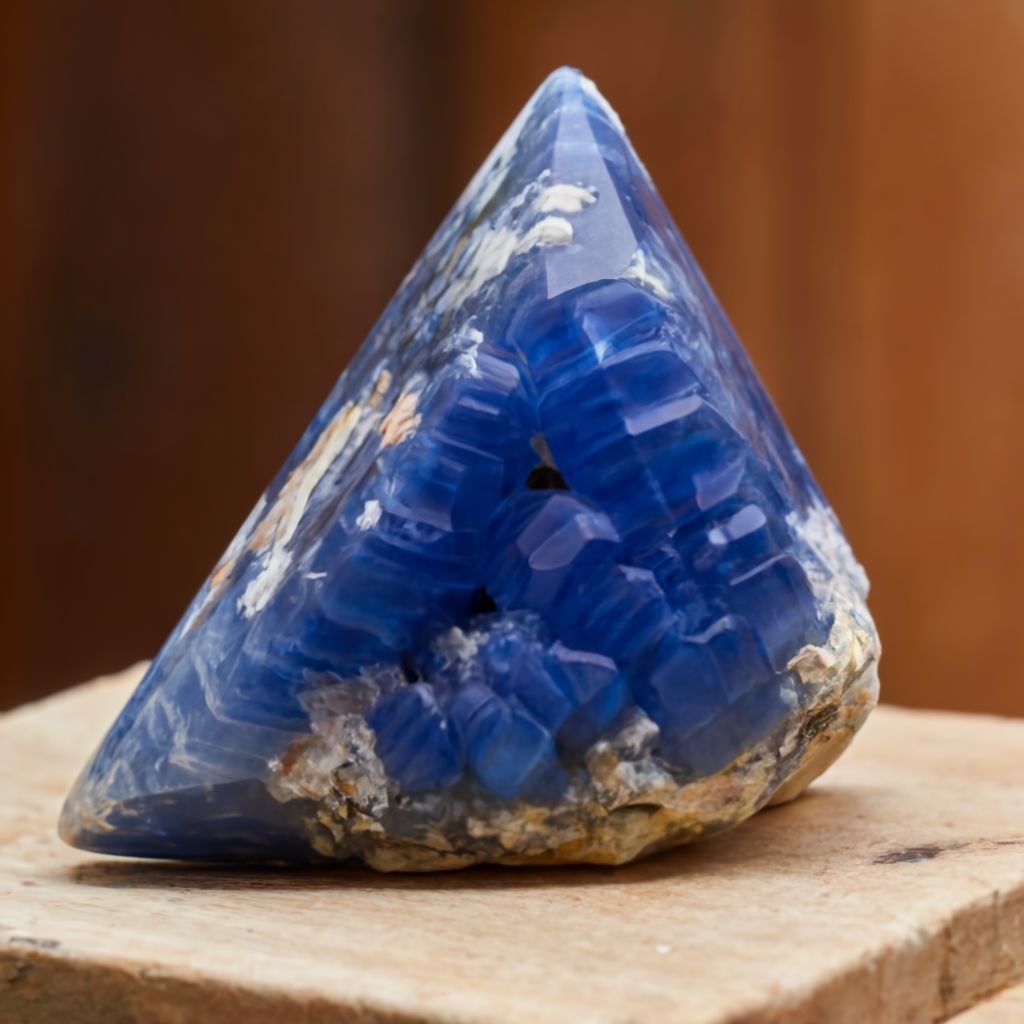
- Definition: Dumortierite quartz is a variety of quartz characterized by the presence of inclusions of dumortierite, a rare blue to violet mineral. These inclusions give the quartz a distinctive blue coloration and often form intriguing patterns within the crystal structure. Dumortierite quartz is prized for its unique beauty and metaphysical properties.
- Formation Process: Dumortierite quartz forms when tiny fibers or crystals of dumortierite are trapped within the growing quartz crystal during its formation. The presence of aluminum and iron within the quartz contributes to the blue coloration of the dumortierite inclusions. The process of crystallization occurs over millions of years under specific geological conditions, resulting in the formation of dumortierite quartz.
- Physical Characteristics: Dumortierite quartz typically exhibits a translucent to opaque appearance with a blue to violet hue. The color intensity can vary from pale blue to deep indigo, depending on the concentration of dumortierite inclusions. The quartz may display a vitreous to waxy luster and often showcases intricate patterns and streaks caused by the arrangement of the dumortierite fibers.
- Metaphysical Properties: Dumortierite quartz is associated with clarity, intuition, and spiritual growth. In metaphysical beliefs, it is considered a stone of insight and enlightenment, aiding in the development of psychic abilities and inner wisdom. Dumortierite quartz is believed to enhance mental clarity, focus, and concentration, making it a valuable tool for meditation and self-discovery.
- Healing Properties: In crystal healing practices, dumortierite quartz is used to promote mental clarity, alleviate stress, and calm the mind. It is believed to stimulate the third eye chakra, facilitating spiritual insight and intuitive guidance. Dumortierite quartz is also thought to promote emotional balance, self-discipline, and inner strength, helping individuals overcome obstacles and achieve their goals.
- Jewelry and Ornamental Use: Dumortierite quartz is prized for its aesthetic appeal and metaphysical properties and is often used in jewelry-making and lapidary arts. It is fashioned into cabochons, beads, and carvings for use in rings, pendants, earrings, and bracelets. Dumortierite quartz jewelry is cherished for its unique coloration and symbolic significance.
- Geological Occurrence: Dumortierite quartz is primarily found in metamorphic rocks, particularly those rich in aluminum and iron minerals. It occurs in regions where the conditions for quartz crystallization coincide with the presence of dumortierite-bearing minerals. Dumortierite quartz deposits are found in various locations around the world, including Brazil, Namibia, Madagascar, and the United States.
- Symbolic Significance: Dumortierite quartz symbolizes clarity, insight, and spiritual growth. Its association with the third eye chakra and intuitive abilities has led to its use as a meditation aid and divination tool. Dumortierite quartz is regarded as a stone of mental clarity and perception, guiding individuals on their spiritual journey and enhancing their connection to higher consciousness.
- Cultural and Historical Significance: Dumortierite quartz has a rich history and has been revered by ancient civilizations for its mystical properties. It was used by spiritual practitioners and healers to access higher realms of consciousness and gain insight into the mysteries of the universe. Dumortierite quartz was also prized for its protective qualities and was often worn as an amulet or talisman for spiritual guidance and wisdom.
- Modern Applications: Today, dumortierite quartz continues to be valued for its beauty and metaphysical properties. It is used in jewelry-making, crystal healing practices, and meditation techniques to harness its spiritual energies and promote mental clarity and insight. Dumortierite quartz is also used in decorative arts and interior design to create a sense of tranquility and spiritual harmony in living spaces.
Sardonyx Quartz:
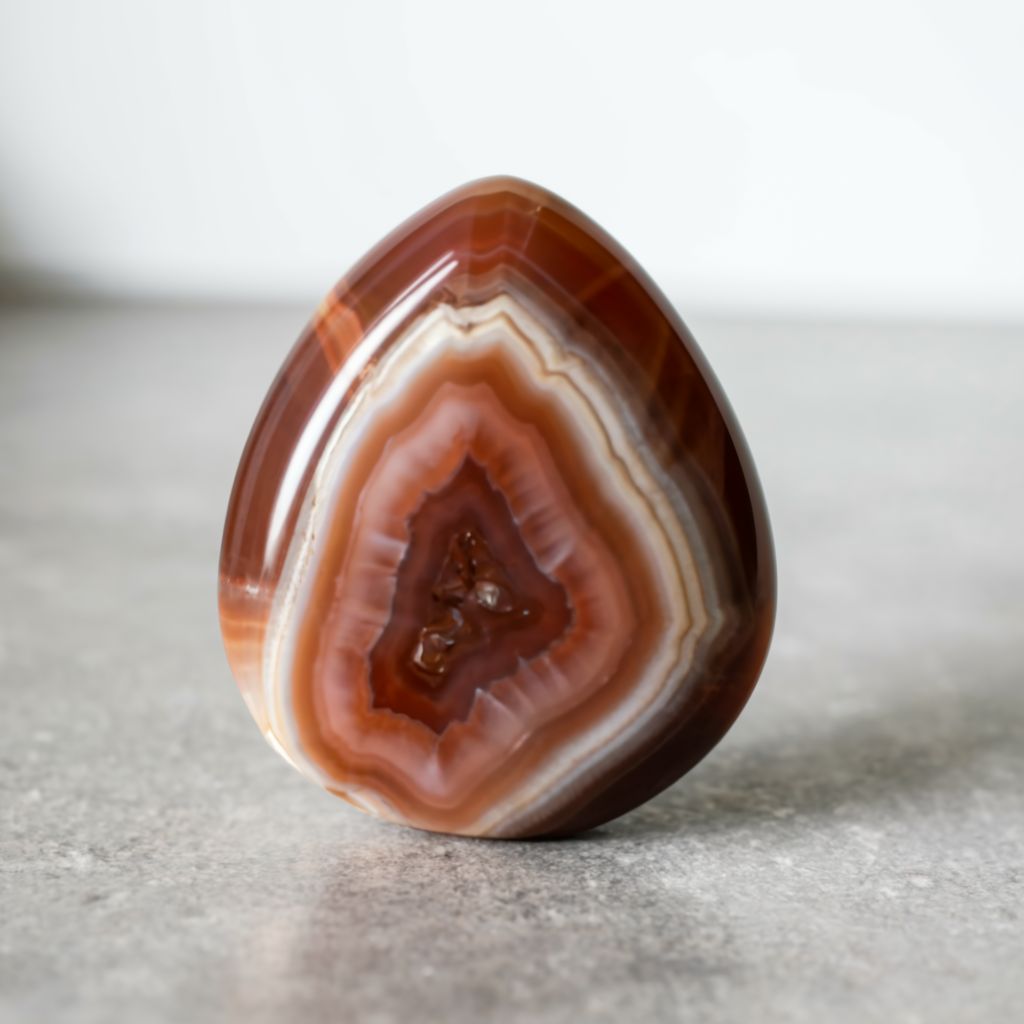
- Definition: Sardonyx quartz is a banded variety of quartz characterized by alternating layers of sard and chalcedony or onyx. It is distinguished by its distinctive bands of reddish-brown sard and white or black chalcedony or onyx, creating a striking contrast of colors and patterns.
- Formation Process: Sardonyx quartz forms through the deposition of layers of sard and chalcedony or onyx in a banded pattern. These bands are created through successive periods of crystallization, where alternating layers of minerals are deposited onto a base rock or matrix. Over time, geological processes such as pressure and heat contribute to the formation and solidification of sardonyx quartz.
- Physical Characteristics: Sardonyx quartz typically exhibits a layered or banded appearance, with alternating bands of reddish-brown sard and white or black chalcedony or onyx. The quartz may display varying degrees of translucency or opacity, depending on the thickness of the bands and the quality of the specimen. Sardonyx quartz often showcases a smooth and polished surface, enhancing its visual appeal.
- Metaphysical Properties: In metaphysical beliefs, sardonyx quartz is associated with strength, protection, and grounding. It is believed to harmonize the energies of sard and chalcedony or onyx, creating a balanced and stabilizing effect. Sardonyx quartz is thought to promote feelings of courage, resilience, and self-discipline, helping individuals overcome challenges and obstacles in their lives.
- Healing Properties: Sardonyx quartz is used in crystal healing practices to enhance physical vitality, endurance, and inner strength. It is believed to provide protection against negative energies and psychic attacks, creating a shield of spiritual armor around the individual. Sardonyx quartz is also thought to promote mental clarity, focus, and determination, assisting individuals in achieving their goals and aspirations.
- Jewelry and Ornamental Use: Sardonyx quartz is highly valued for its striking appearance and symbolic significance, making it a popular choice for jewelry and decorative items. It is often cut into cabochons, beads, and cameos for use in rings, pendants, earrings, and bracelets. Sardonyx quartz jewelry is cherished for its unique beauty and timeless elegance, symbolizing strength, protection, and perseverance.
- Geological Occurrence: Sardonyx quartz is found in various geological settings, including metamorphic and sedimentary rocks. It occurs in regions where quartz deposits interact with iron-rich minerals and silica-rich solutions, leading to the formation of banded sardonyx. Sardonyx quartz deposits are found in locations around the world, including Brazil, India, Madagascar, and the United States.
- Symbolic Significance: Sardonyx quartz symbolizes courage, resilience, and harmony. Its contrasting bands of sard and chalcedony or onyx represent the balance between strength and gentleness, power and protection. Sardonyx quartz is often used as a talisman for courage and endurance, inspiring individuals to face challenges with confidence and determination.
- Cultural and Historical Significance: Throughout history, sardonyx quartz has been revered for its beauty and symbolic significance. It has been used by ancient civilizations for amulets, seals, and signet rings, symbolizing strength, protection, and wisdom. Sardonyx quartz was prized for its association with courage and self-discipline, making it a cherished gemstone among warriors and leaders.
- Modern Applications: Today, sardonyx quartz continues to be valued for its aesthetic appeal and metaphysical properties. It is used in jewelry-making, crystal healing practices, and spiritual rituals to harness its protective and grounding energies. Sardonyx quartz is also used in decorative arts and interior design to evoke feelings of strength, harmony, and resilience in living spaces.
Flint Quartz:
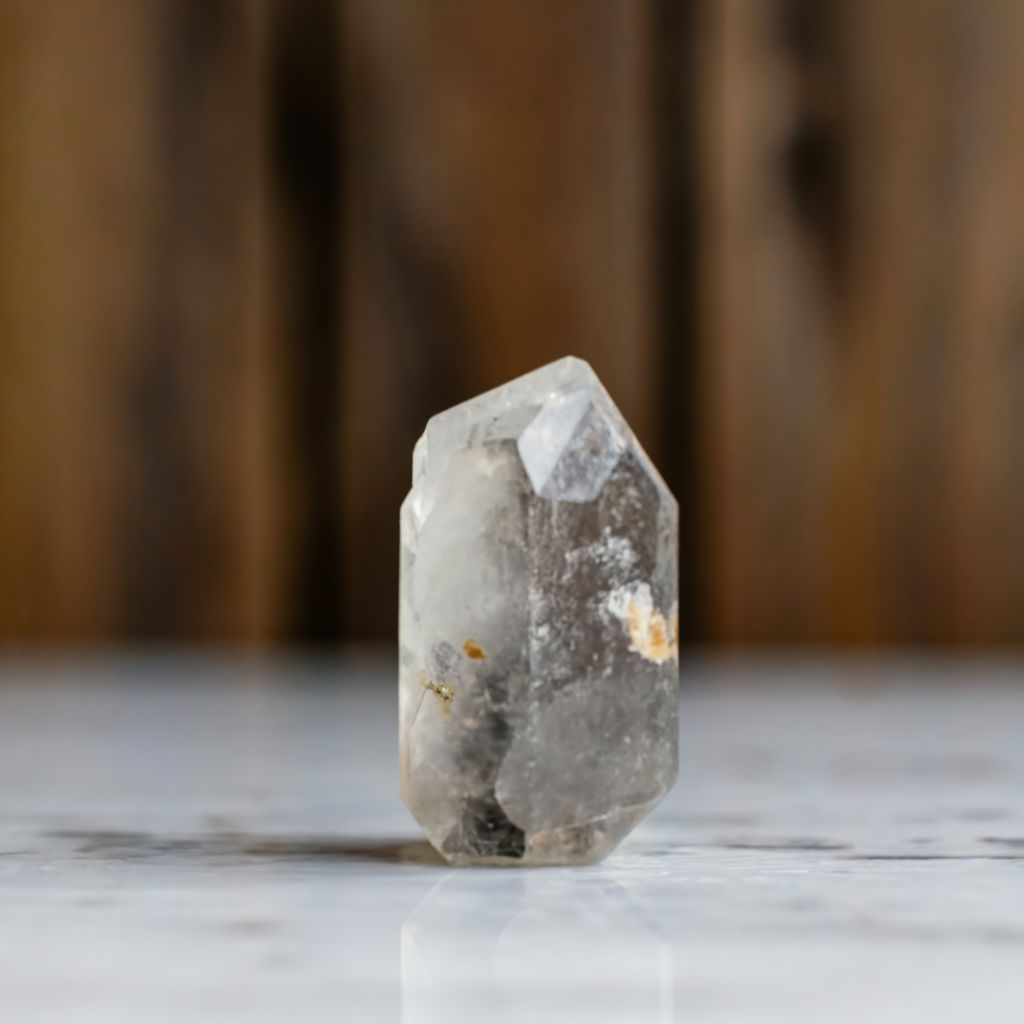
- Definition: Flint quartz is a variety of quartz that typically occurs as nodules or masses within sedimentary rocks, such as chalk and limestone. It is known for its distinctive conchoidal fracture and ability to produce sparks when struck against steel. Flint quartz is composed primarily of microcrystalline quartz, often exhibiting shades of gray, black, or brown.
- Formation Process: Flint quartz forms through the chemical alteration and replacement of organic remains within sedimentary deposits, such as siliceous microfossils and sponge spicules. Over millions of years, silica-rich groundwater percolates through porous rocks, depositing layers of cryptocrystalline quartz in the form of chert or flint. Geological processes such as compaction, cementation, and diagenesis contribute to the solidification and preservation of flint quartz.
- Physical Characteristics: Flint quartz typically exhibits a dense and compact texture, with a hardness of around 7 on the Mohs scale. It is characterized by its conchoidal fracture, which produces sharp-edged fragments when fractured. Flint quartz may display varying degrees of translucency or opacity, depending on its mineral composition and impurities. It is often found as nodules or layers within sedimentary rock formations.
- Metaphysical Properties: In metaphysical beliefs, flint quartz is associated with protection, grounding, and transformation. It is believed to absorb and transmute negative energies, creating a shield of spiritual protection around the individual. Flint quartz is thought to promote feelings of strength, resilience, and perseverance, helping individuals overcome challenges and adversity in their lives.
- Healing Properties: Flint quartz is used in crystal healing practices to promote physical vitality, emotional stability, and mental clarity. It is believed to stimulate the root chakra, facilitating a sense of grounding and stability within the body and mind. Flint quartz is also thought to enhance focus, concentration, and decision-making abilities, assisting individuals in manifesting their intentions and goals.
- Archaeological Significance: Flint quartz has been prized by ancient civilizations for its hardness, durability, and ability to produce sparks when struck against steel. It was used by early humans to create tools, weapons, and ceremonial objects, playing a significant role in the development of human civilization. Flint artifacts have been discovered at archaeological sites around the world, providing insights into prehistoric cultures and technologies.
- Cultural Symbolism: Flint quartz holds cultural significance as a symbol of resilience, resourcefulness, and adaptability. It has been revered by indigenous cultures for its practical and spiritual properties, serving as a talisman for protection and survival. Flint quartz artifacts feature prominently in folklore, mythology, and spiritual rituals, representing the enduring strength and ingenuity of the human spirit.
- Geological Occurrence: Flint quartz is found in sedimentary rock formations worldwide, particularly in regions with abundant chalk and limestone deposits. It occurs as nodules, layers, or veins within these rocks, often associated with ancient marine environments and fossil-rich strata. Flint quartz deposits are found in locations across Europe, North America, Africa, and Asia, where it has been utilized by humans for thousands of years.
- Modern Applications: Today, flint quartz continues to be valued for its historical significance, aesthetic appeal, and metaphysical properties. It is used in jewelry-making, lapidary arts, and ornamental objects, where its unique texture and coloration are prized for decorative purposes. Flint quartz is also utilized in industrial applications, such as abrasives, filtration media, and ceramic production, due to its hardness and durability.
Clear Quartz:
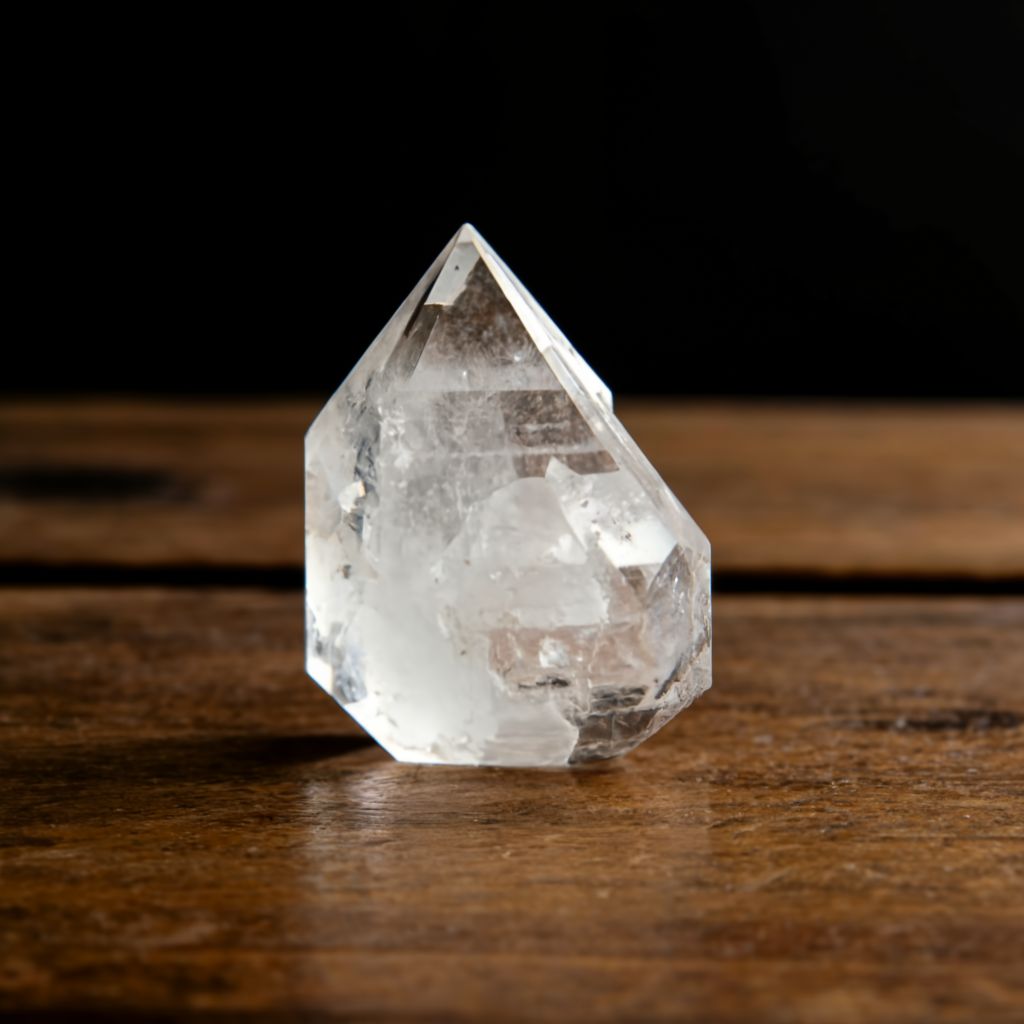
- Ancient Utilization: Clear quartz, also known as rock crystal, has been integral to human civilization since ancient times. Its translucency and clarity made it a prized material for various purposes, including toolmaking, ornamentation, and spiritual practices.
- Historical Significance: Clear quartz holds historical significance as one of the earliest materials used by humans. Its versatility and durability made it suitable for crafting tools such as knives, arrowheads, and scraping implements. The term “quartz” itself may stem from ancient Slavic languages, reflecting its reputation for hardness and utility.
- Amulets and Talismans: In antiquity, clear quartz crystals were often worn as protective amulets and talismans. Believed to possess mystical properties, they were thought to ward off negative energy, evil spirits, and misfortune. Their transparent appearance symbolized clarity of thought, purity of spirit, and spiritual enlightenment.
- Spiritual and Metaphysical Beliefs: Clear quartz has long been associated with spiritual practices and metaphysical beliefs. It is revered for its ability to amplify energy, enhance intuition, and promote spiritual awareness. Practitioners of crystal healing and alternative medicine often use clear quartz as a tool for meditation, energy cleansing, and chakra balancing.
- Crystal Balls and Divination: Clear quartz spheres, known as crystal balls, hold a prominent place in divination and mystical traditions. Seers and fortune-tellers believed that gazing into a polished quartz sphere could reveal insights into the past, present, and future. The clear, reflective surface of the crystal ball was thought to channel cosmic energy and unlock hidden truths.
- Modern Applications: In contemporary times, clear quartz continues to be valued for its aesthetic beauty and metaphysical properties. It is widely used in jewelry-making, crystal therapy, and holistic healing practices. Its transparent appearance and natural brilliance make it a popular choice for gemstone enthusiasts and collectors.
- Scientific and Industrial Uses: Beyond its spiritual and decorative applications, clear quartz has practical uses in science and industry. Its optical clarity and thermal stability make it ideal for optical instruments, laboratory equipment, and precision components. Clear quartz crystals are also used in electronic devices, sensors, and telecommunications technology.
- Symbol of Clarity and Renewal: Clear quartz symbolizes clarity of thought, purity of intention, and renewal of energy. Its transparent nature reflects the unobstructed flow of energy and the potential for spiritual growth and transformation. As a symbol of enlightenment and inner wisdom, clear quartz inspires individuals to seek truth, embrace change, and manifest their highest aspirations.
Chert Quartz:
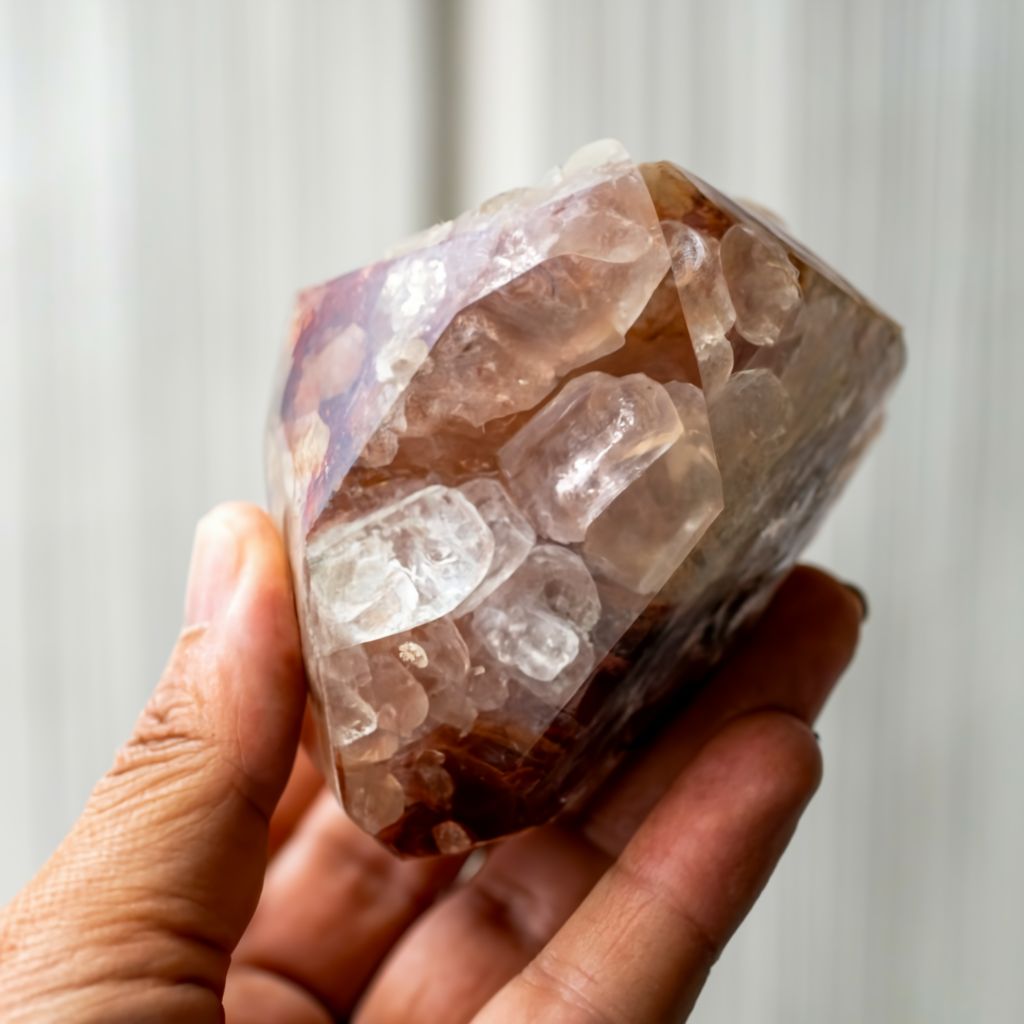
- Historical Significance: Chert quartz, a dense and microcrystalline form of silica, has played a significant role in human history. From ancient toolmaking to modern scientific inquiry, chert has been utilized for various purposes due to its hardness and abundance in nature.
- Ancient Toolmaking: Chert quartz has a long history as a material for toolmaking among early human societies. Its conchoidal fracture and hardness, comparable to quartz, made it suitable for crafting implements such as arrowheads, knives, scrapers, and other cutting tools. Archaeological evidence suggests that chert artifacts date back thousands of years, showcasing its importance to ancient civilizations.
- Abundance in Nature: Chert is commonly found in sedimentary rocks, particularly in limestone and chalk formations. Its formation often occurs through the deposition of silica-rich sediment, followed by compaction and cementation over geological time. Chert nodules and layers can be found in various environments, including riverbeds, coastal cliffs, and desert landscapes.
- Physical Characteristics: Chert quartz exhibits a microcrystalline structure, composed primarily of silica (silicon dioxide) with varying degrees of impurities. Its coloration ranges from white and gray to brown, black, or red, depending on the presence of organic matter, iron oxides, or other minerals.
- Practical Applications: While chert may lack the transparency and optical properties of crystalline quartz, it has practical applications in construction, landscaping, and industrial processes. Crushed chert aggregates are used as construction material for road base, concrete, and railway ballast due to their durability and resistance to weathering.
- Geological Formation: The formation of chert involves the accumulation and compaction of silica-rich sediments, often in marine environments. Over time, these sediments undergo diagenesis, a process of chemical and physical changes, resulting in the transformation of amorphous silica into microcrystalline chert.
- Scientific Study: Chert is of interest to geologists and paleontologists for its role in preserving fossils and sedimentary structures. In sedimentary rocks, chert nodules often encapsulate fossils, providing insights into ancient marine ecosystems and depositional environments. The study of chert can help reconstruct past geological processes and climates.
- Symbolism and Cultural Significance: In some cultures, chert holds symbolic significance as a material associated with strength, resilience, and endurance. Its use in toolmaking reflects human ingenuity and adaptability in harnessing natural resources for survival and innovation. Chert artifacts found in archaeological sites offer glimpses into the technological advancements and cultural practices of ancient civilizations.
Ametrine Quartz:
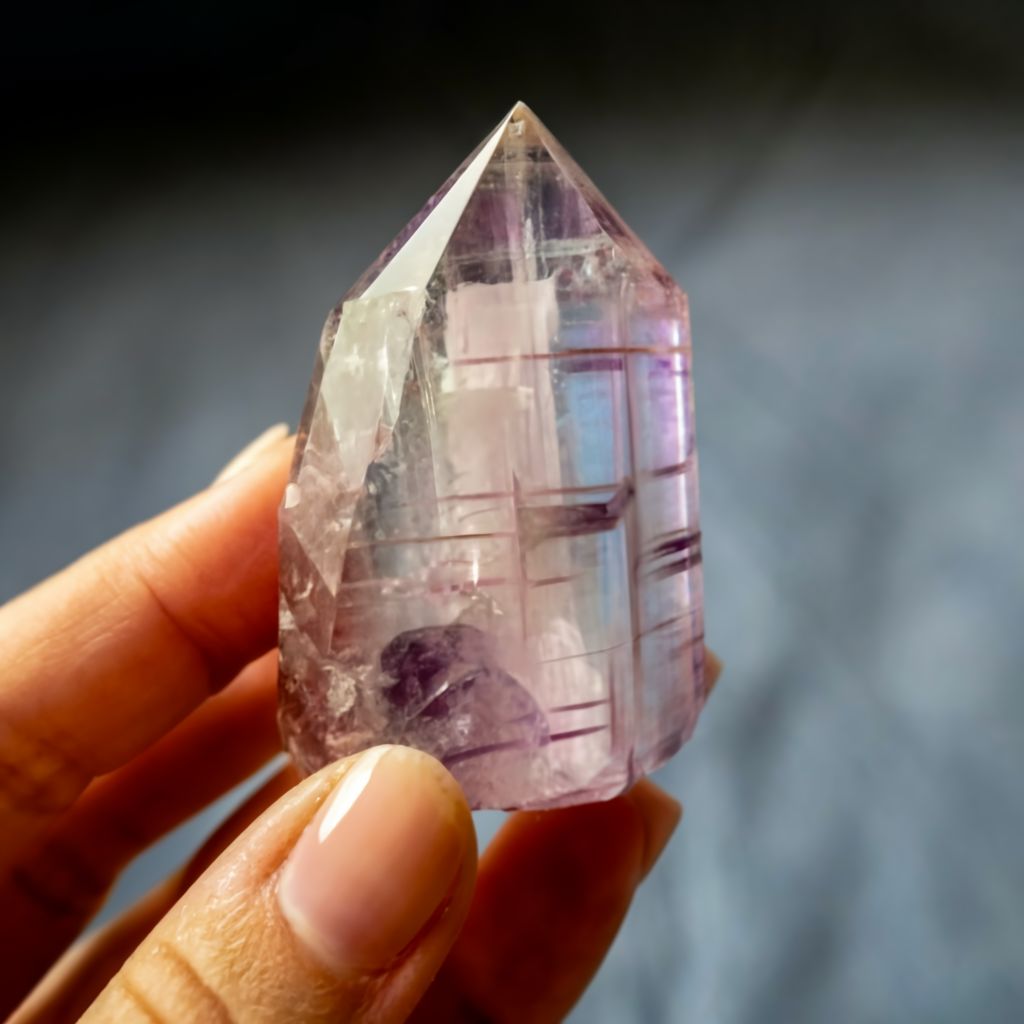
- Natural Fusion: Ametrine quartz is a unique gemstone that combines the properties of amethyst and citrine within a single crystal. It features zones or sectors of purple amethyst and yellow citrine, creating a distinct color gradient within the gemstone.
- Origin and Formation: The formation of ametrine occurs in areas where amethyst and citrine crystals grow together within the same geologic environment. This phenomenon is relatively rare and is believed to result from variations in temperature and oxidation states during the crystal’s growth process.
- Coloration and Appearance: Ametrine quartz exhibits a striking blend of purple and yellow hues, with transitions between the two colors often occurring naturally within the crystal. The precise color distribution and intensity can vary, resulting in unique patterns and visual appeal.
- Gemstone Quality: Ametrine is valued for its clarity, color consistency, and overall beauty. Gem-quality specimens are carefully cut and polished to showcase the distinct color zoning and maximize their aesthetic appeal. The gemstone is commonly faceted to enhance its brilliance and play of light.
- Symbolism and Meaning: Ametrine is associated with balance, harmony, and spiritual alignment. It is believed to integrate the energies of amethyst and citrine, promoting mental clarity, creativity, and emotional well-being. Some practitioners use ametrine for meditation, chakra balancing, and aura cleansing.
- Metaphysical Properties: In metaphysical traditions, ametrine is regarded as a stone of abundance, prosperity, and positive transformation. It is said to stimulate the mind, uplift the spirit, and dispel negative energies. Ametrine is also associated with the solar plexus and crown chakras, promoting inner strength and spiritual insight.
- Jewelry and Ornamental Use: Ametrine is popularly used in jewelry, including rings, pendants, earrings, and bracelets. Its vibrant colors and unique appearance make it a sought-after gemstone for both casual and formal wear. Jewelry designers often incorporate ametrine into custom pieces to highlight its distinctive beauty.
- Cultural and Historical Significance: While relatively recent in terms of gemstone recognition, ametrine has quickly gained popularity among gem enthusiasts and collectors. Its mesmerizing coloration and metaphysical properties have captured the imagination of people around the world, contributing to its growing demand in the gemstone market.
Azotic Quartz:

- Unique Treatment: Azotic quartz is a specialized form of quartz that undergoes a treatment process to enhance its color and appearance. It is distinct from naturally occurring quartz varieties and is valued for its vibrant hues and iridescent effects.
- Treatment Process: The treatment of azotic quartz involves applying a thin metallic coating to the surface of clear quartz crystals. This coating, often composed of metal oxides, creates a rainbow-like sheen or metallic luster that enhances the visual appeal of the quartz.
- Color Enhancement: Azotic quartz can exhibit a range of colors, including vivid blues, greens, purples, and pinks, depending on the specific metallic coatings used during the treatment process. The colors are often bright and eye-catching, adding a unique dimension to the quartz’s appearance.
- Appearance and Visual Effects: The metallic coating on azotic quartz creates iridescence and color play, similar to the effect seen in natural phenomena like opals and peacock feathers. When viewed from different angles or under varying lighting conditions, azotic quartz displays a dynamic range of colors and reflections.
- Versatile Applications: Azotic quartz is popularly used in jewelry making and ornamental pieces where vibrant colors and visual interest are desired. It is commonly faceted or shaped into beads, cabochons, and other decorative forms to showcase its iridescent qualities.
- Care and Maintenance: While azotic quartz is visually stunning, it may require special care to preserve its appearance. The metallic coating can be delicate and may be susceptible to scratching or damage from harsh chemicals. It is advisable to handle azotic quartz with care and avoid exposing it to abrasive substances.
- Aesthetic Appeal: Azotic quartz offers a contemporary and stylish alternative to traditional gemstones, appealing to individuals seeking bold and unconventional jewelry designs. Its captivating colors and shimmering effects make it a popular choice for statement pieces and fashion-forward accessories.
- Artificial Enhancement: It’s important to note that azotic quartz undergoes artificial enhancement processes to achieve its distinctive appearance. While this treatment enhances the gemstone’s visual appeal, it may affect its value and durability compared to naturally occurring gemstones. Consumers should be aware of the treatment methods used and consider them when evaluating the gemstone’s suitability for their needs.
Blue Quartz:
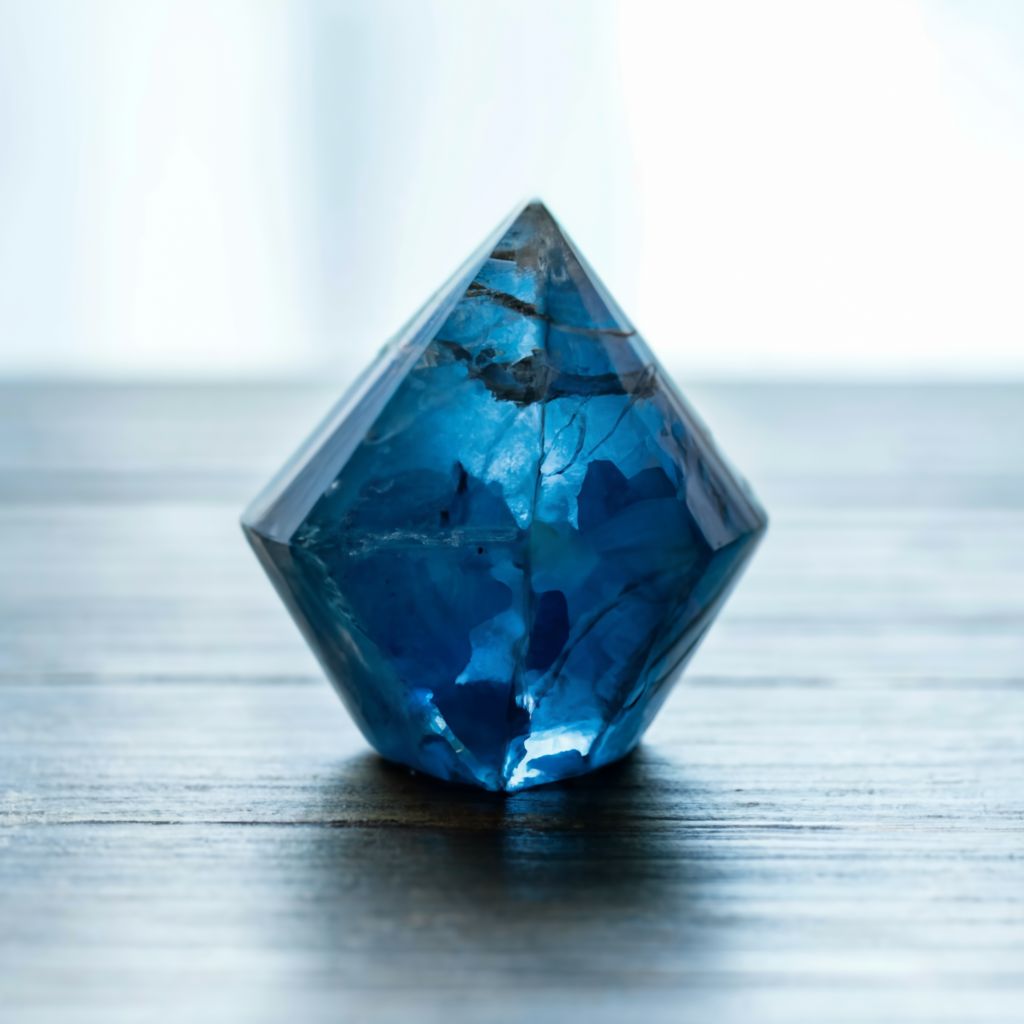
- Natural Formation: Blue quartz is a variety of quartz characterized by its blue coloration, which is caused by inclusions of other minerals or microscopic fibers within the crystal structure. These inclusions may include minerals like dumortierite, tourmaline, or rutile.
- Color Variation: Blue quartz can exhibit a range of blue shades, from pale sky blue to deeper hues resembling the color of the ocean. The intensity and saturation of the blue coloration may vary depending on the concentration and type of inclusions present.
- Transparency and Clarity: Blue quartz typically possesses a translucent to opaque appearance, with varying degrees of transparency depending on the crystal’s quality and purity. In some specimens, the blue coloration may be evenly distributed throughout the quartz matrix, while in others, it may appear as patches or streaks.
- Metaphysical Properties: In metaphysical beliefs, blue quartz is associated with promoting clarity of mind, enhancing communication, and facilitating spiritual insight. It is often regarded as a calming and soothing stone that helps alleviate stress, anxiety, and emotional turmoil.
- Symbolism and Significance: Blue quartz is sometimes used as a symbol of serenity, peace, and tranquility. Its calming energy is believed to promote harmony and balance, making it a popular choice for meditation practices and spiritual rituals aimed at promoting inner peace and emotional well-being.
- Jewelry and Ornamental Use: Blue quartz is valued for its aesthetic appeal and is commonly used in jewelry making, decorative objects, and lapidary art. It can be fashioned into beads, cabochons, pendants, and other ornamental pieces, showcasing its natural beauty and unique coloration.
- Enhancement Techniques: In some cases, blue quartz may undergo treatment processes to enhance its color or clarity. These treatments may include heat treatment or irradiation to intensify the blue hue or improve the stone’s overall appearance. It’s essential for consumers to inquire about any treatments applied to blue quartz when purchasing gemstones.
- Care and Maintenance: Like other varieties of quartz, blue quartz is relatively durable and requires minimal maintenance. It can be cleaned using mild soap and water or a soft brush to remove dirt and debris. Avoid exposing blue quartz to harsh chemicals or abrasive materials that may scratch or damage the surface.
- Availability and Sourcing: Blue quartz can be found in various locations around the world, including Brazil, Madagascar, India, and the United States. It is commonly mined from quartz deposits or extracted as a byproduct of other mining operations. High-quality specimens with vibrant blue coloration are sought after by collectors and enthusiasts in the gemstone industry.
Chakras:

| Chakra | Quartz Properties |
|---|---|
| Third Eye | Awakens and benefits the Third Eye Chakra |
| Crown | Empowers the Crown Chakra, facilitates connection to the other realm |
Zodiac Birthstone:
Quartz: Birthstone for Aries
- Beloved Birthstone:
- Quartz is a cherished birthstone specifically associated with individuals born under the zodiac sign of Aries.
- Aries, known for their passionate and ambitious nature, benefit from the supportive properties of Quartz.
- Calming Influence:
- Aries personalities often exhibit high levels of passion and drive, which can sometimes lead to burnout or emotional intensity.
- Quartz serves as a calming influence, offering a cool touch that helps to regulate emotional overdrive characteristic of Aries individuals.
- Emotional Balance:
- The calming energy of Quartz helps Aries individuals achieve emotional balance amidst their ambitious pursuits.
- By promoting tranquility and clarity of mind, Clear Quartz aids in preventing emotional exhaustion and maintaining equilibrium.
- Support for Ambition:
- While Aries individuals possess admirable traits such as passion and ambition, they may require support to prevent overwhelm and maintain sustainable energy levels.
- Quartz acts as a supportive ally, offering clarity of purpose and aiding in the manifestation of Aries’ ambitious goals.
- Alignment with Aries Traits:
- Quartz resonates with the dynamic and assertive qualities often associated with Aries individuals.
- Its ability to enhance focus and provide emotional stability aligns well with the traits and tendencies of those born under the sign of Aries.
Uses:
| Use | Description |
|---|---|
| Glassmaking | High purity silica sand sourced from quartz deposits is used in glass production |
| Abrasive Material | Quartz’s hardness makes it an excellent abrasive material used for sand blasting, scouring cleansers, grinding, and sanding |
| Foundry Sand | Resistant to heat and chemicals, quartz sand is used in foundries for molds, cores, and refractory bricks |
| Smelting Flux | Quartz sand is utilized as a flux in metal smelting processes to facilitate melting of metals |
| Hydraulic Fracturing | Quartz sand is injected into oil and gas wells to keep fractures open, allowing natural gas flow |
| Filler Material | Used in rubber, paint, putty manufacture as filler material |
| Filter Media | Screened and washed quartz grains serve as filter media in various industries |
| Traction and Recreation | Quartz sands used for traction in railroad and mining industries; also for sports fields, beaches, and sandboxes |
| Gemstone | Quartz varieties like amethyst, citrine, rose quartz, aventurine, agate, and jasper are popular gemstones |
| Silica Stone | Includes quartzite, novaculite, used in abrasive tools, grinding stones, oilstones, tube-mill liners, and whetstones |
| Tripoli | Fine crystalline silica used in abrasives, polishes, toothpaste, metal-polishing compounds, brake friction products, etc. |
Origin:
One of the most prevalent minerals on the planet, quartz can be found in a variety of rocks, such as igneous, metamorphic, and sedimentary rocks. It is especially prevalent in sedimentary rocks like sandstones and cherts, as well as rocks of the continental crust like granites and rhyolites.
| Location | Description |
|---|---|
| Alps, Switzerland and Austria | Fine specimens found in various locations in the Alps region of Switzerland and Austria |
| Carrara, Tuscany, Italy | Quartz specimens sourced from Carrara, Tuscany, known for its marble quarries |
| Bourg d’Oisans, Isµere, France | Quartz specimens found in Bourg d’Oisans, Isµere, France |
| Ural Mountains, Russia | Found in Mursinka and Dodo mine in the Ural Mountains, as well as other locations in Russia |
| Sakangyi, Katha district, Myanmar | Quartz specimens discovered in Sakangyi, Katha district, Myanmar (Burma) |
| Yamanashi Prefecture, Japan | Large twins and specimens from various places in Yamanashi Prefecture, Japan |
| Tamboholehehibe, Madagascar | Quartz specimens found in Tamboholehehibe and other locations in Madagascar |
| Brazil | Abundant specimens from numerous localities in Rio Grande do Sul, Minas Gerais, Goilas, and Bahia, Brazil |
| Artigas, Uruguay | Quartz specimens around Artigas, Uruguay |
| Thunder Bay, Lake Superior, Canada | Quartz specimens found in Thunder Bay area, Lake Superior, Ontario, Canada |
| USA | Found in various states: Arkansas, New York, North Carolina, California, New Mexico, Montana, Colorado |
| Mexico | Found in Veracruz and Guerrero regions of Mexico |
How to Clean?
- Cleansing Ritual:
- Start by cleansing your Quartz to wash away any energetic blockages.
- Rinse the quartz under running water to purify it, and gently polish it with a soft dry cloth to remove any impurities.
- Soaking Method:
- Consider soaking your Quartz in a glass of mineral water to allow it to rejuvenate and cleanse thoroughly.
- This soaking method helps to refresh the quartz and revitalize its energy.
- Charging under the Full Moon:
- To infuse your Quartz with renewed energy, place it under the light of a full moon.
- The full moon’s powerful energy can amplify the healing properties of the quartz and enhance its effectiveness.
- Harnessing Lunar Energy:
- The energy of the full moon is believed to be particularly potent for charging crystals and stones.
- By exposing your Quartz to the moon’s luminous rays, you can tap into its revitalizing energy and amplify the crystal’s healing vibrations.
- Involvement in Smudging Sessions:
- Another method to refresh Quartz is to involve it in a smudging session.
- Smudging, typically using sage or other herbs, helps to clear away stagnant or negative energies surrounding the crystal, allowing it to absorb new, positive vibrations.
- Exercise Caution with Quartz Clusters:
- When cleansing quartz clusters, exercise a more delicate approach to avoid damaging the delicate formations.
- Handle quartz clusters with care during cleansing and charging rituals to preserve their natural beauty and integrity.
Conclusion:
Quartz stands as a versatile mineral with a rich array of types and properties. From its sturdy crystalline structure to its diverse forms like agate and amethyst, quartz embodies resilience and adaptability. Its utility spans from jewelry-making to high-tech applications like semiconductors. Through its varied crystallographic formations, quartz showcases the intricate beauty of the natural world. As we marvel at its enduring presence, quartz serves as a timeless symbol of the intricacies and wonders of Earth’s geology.
FAQs:
- What are the different types of quartz?
- Quartz comes in various types, including amethyst, agate, rose quartz, and citrine, each distinguished by its unique color and crystalline structure.
- What properties make quartz a valuable mineral?
- Quartz boasts exceptional hardness, durability, and resistance to mechanical and chemical weathering, making it suitable for a wide range of applications.
- How is quartz utilized in jewelry-making?
- Quartz varieties like amethyst and rose quartz are popular choices for jewelry due to their attractive colors and clarity. They are often cut and polished into gemstones for use in rings, necklaces, and earrings.
- What role does quartz play in technology?
- Quartz crystals are utilized in various technological applications, including oscillators for quartz clocks and semiconductors for electronic devices due to their precise vibrational properties.
- What are the different crystallographic formations of quartz?
- Quartz crystals can exhibit a range of formations, from prismatic with horizontal striations to twinned specimens and concretionary masses, showcasing the mineral’s diverse beauty and complexity.
- Where is quartz found geologically?
- Quartz is widely distributed in Earth’s continental crust and can be found in igneous, metamorphic, and sedimentary rocks. It is abundant in mountainous regions, riverbeds, and coastal areas.
- What makes quartz a symbol of resilience and adaptability?
- Quartz’s enduring presence in various geological formations and its ability to withstand both natural forces and human activities highlight its resilience and adaptability in diverse environments.

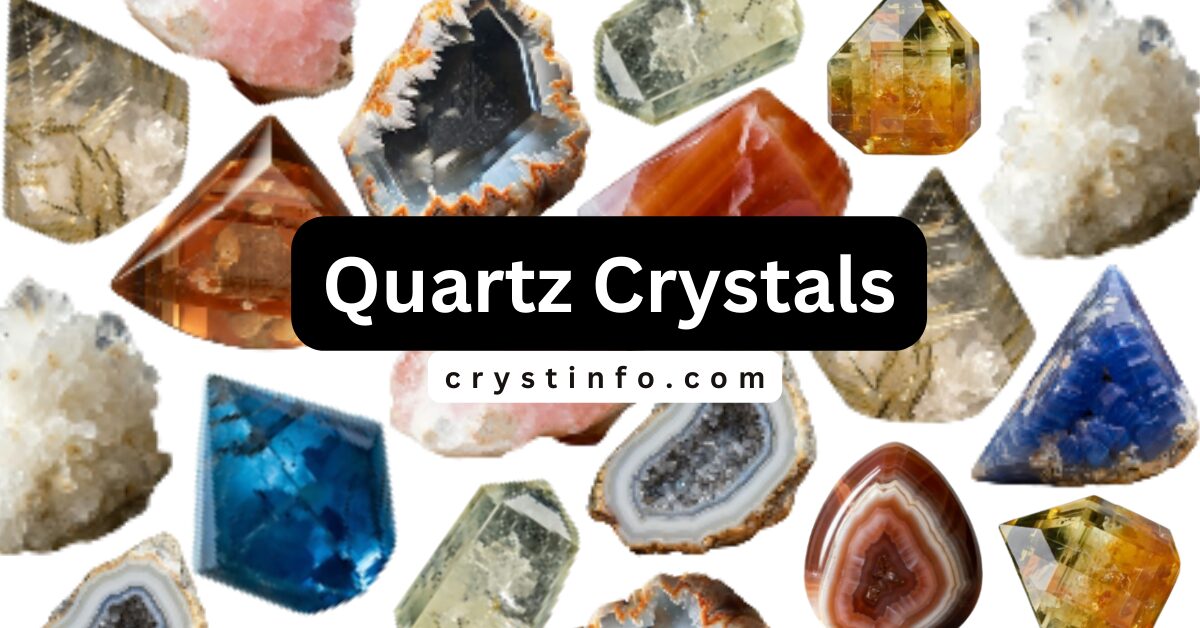
![Tree Agate:Unveiling the Secrets[ Dendritic Agate]](https://crystinfo.com/wp-content/uploads/2024/01/Chakras-12-768x402.jpg)
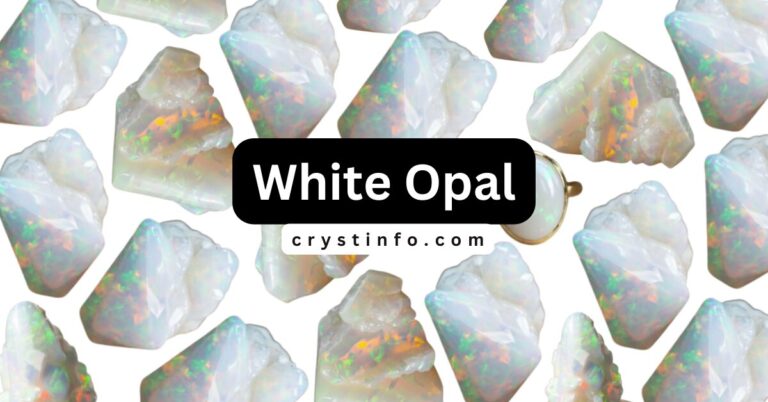
![Apache Tears: Unveiling Obsidian Power and [Emotional Transformation]](https://crystinfo.com/wp-content/uploads/2024/01/Chakras-4-768x402.jpg)
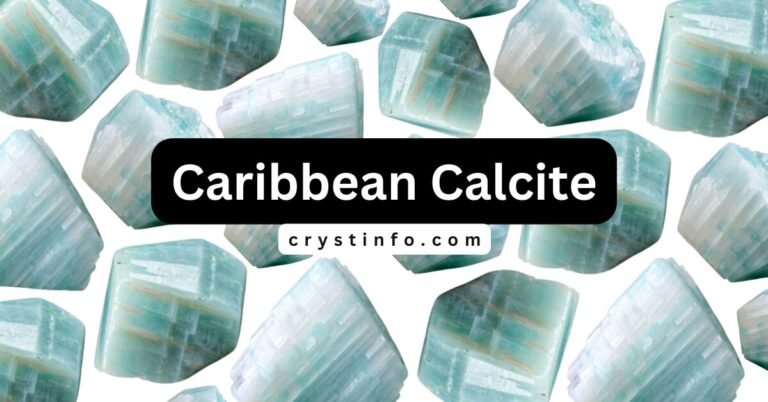
![Snowflake Obsidian: Unleashing Healing Energies for Your [Well-being]](https://crystinfo.com/wp-content/uploads/2023/12/Add-a-heading-15-768x402.jpg)
